Search Result
Results for "
CYP activity
" in MedChemExpress (MCE) Product Catalog:
22
Isotope-Labeled Compounds
| Cat. No. |
Product Name |
Target |
Research Areas |
Chemical Structure |
-
- HY-N0453
-
-

-
- HY-N0482
-
-
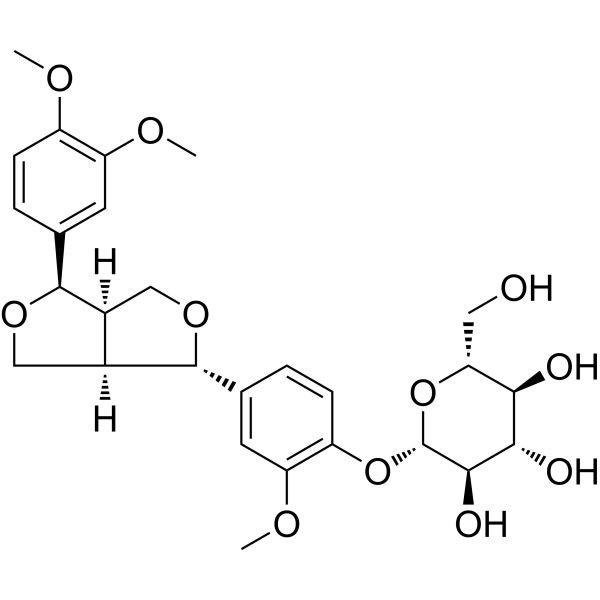
-
- HY-155493
-
|
|
Cytochrome P450
|
Cancer
|
|
CYP19A1/CYP11B2-IN-1 (Compound X21) is a potent and selective aromatase and
aldosterone synthase dual inhibitor with IC50s of 2.3 nM and 29 nM for aromatase (CYP19A1) and aldosterone synthase (CYP11B2), respectively. CYP19A1/CYP11B2-IN-1 has excellent antiproliferative and pro-apoptotic activity against the cancer cell. CYP19A1/CYP11B2-IN-1 can be used for research of breast cancer .
|
-
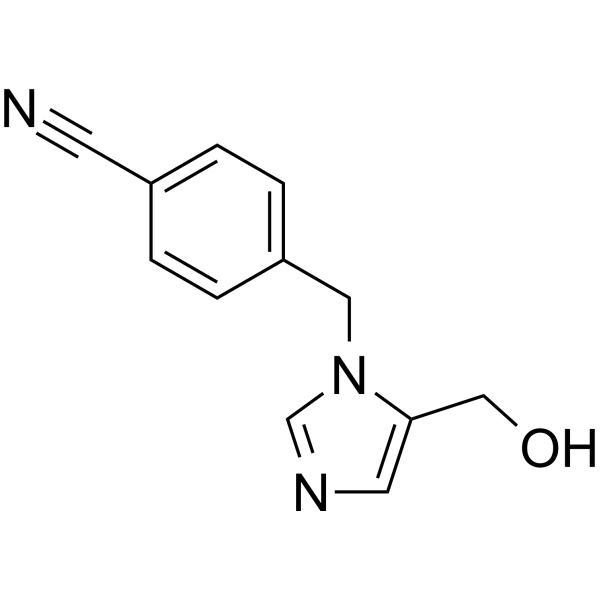
-
- HY-116862
-
|
DBF
|
Cytochrome P450
Fluorescent Dye
|
Others
|
|
Dibenzylfluorescein (DBF) is a fluorogenic probe (Fluoresecent dye) that acts as a substrate for specific cytochrome P450 (CYP) isoforms, including CYP3A4, CYP2C8, CYP2C9, CYP2C19, and aromatase (CYP19). Dibenzylfluorescein is typically used near its Km value of 0.87-1.9 µM (Ex=485nm,Em=535nm). Dibenzylfluorescein is used to detect changes in CYP catalytic activity caused by drugs or disease .
|
-
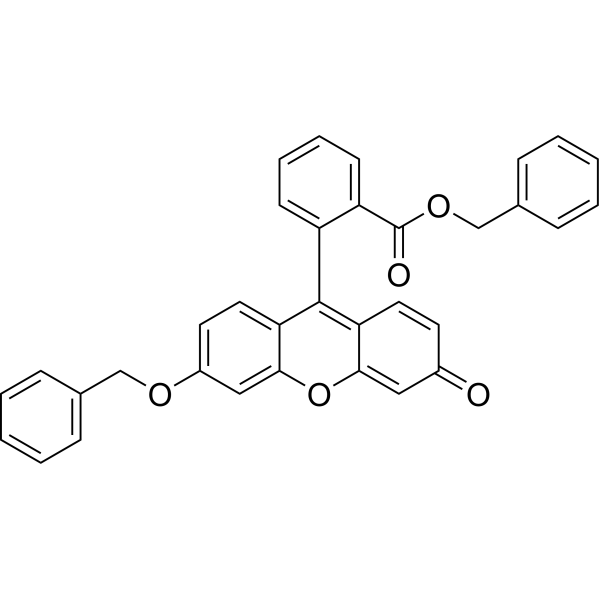
-
- HY-162370
-
|
|
Cytochrome P450
|
Infection
Cancer
|
|
CYP51-IN-16 (compound C6) is a phenylpyrimidine CYP51 inhibitor, and shows antifungal activity in in vitro. CYP51-IN-16 inhibits tumor cell growth .
|
-
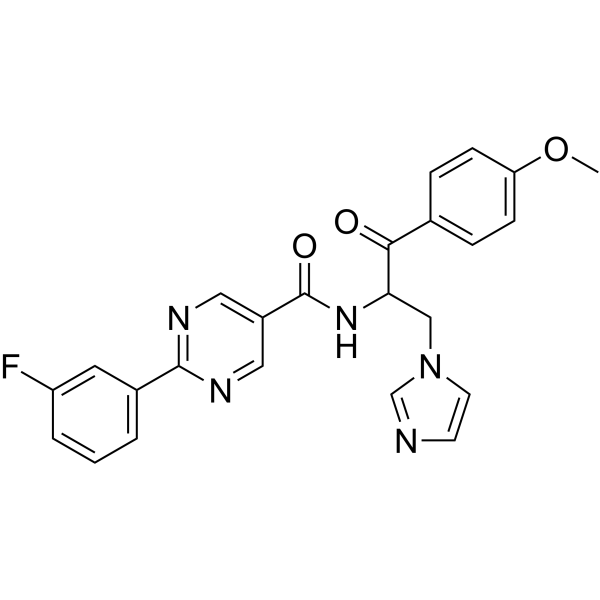
-
- HY-18642
-
|
PF-4981517
|
Cytochrome P450
|
Others
|
|
CYP3cide (PF-4981517) is a potent, selective and time-dependent inhibitor of cytochrome P4503A4 (CYP3A4). The IC50 values for Midazolam 1’-hydroxylase activity are 0.03 μM, 17 μM, and 71 μM for CYP3A4, CYP3A5, and CYP3A7, respectively. CYP3cide can be used to distinguish the contributions of CYP3A4 versus CYP3A5 on agent metabolism .
|
-

-
- HY-N0893S
-
-
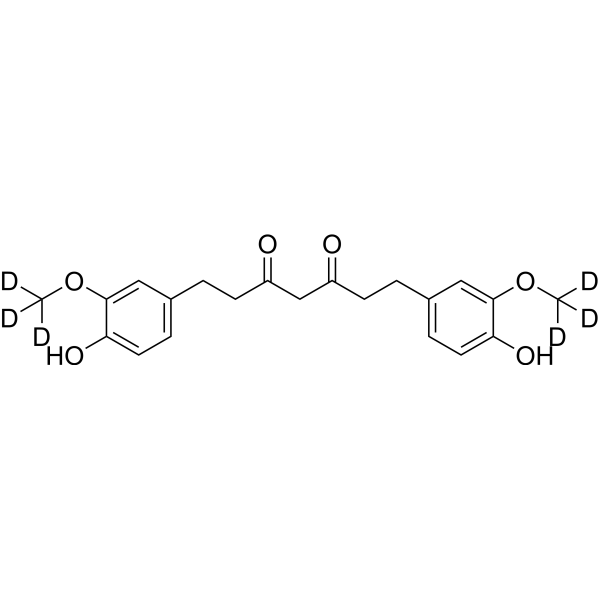
-
- HY-162051
-
|
|
Cytochrome P450
|
Cancer
|
|
CYP1B1-IN-6 (compound 19) is a fluorescence molecular probes which inhibits CYP1B1 activity. CYP1B1-IN-6 can identify tumor sites in fluorescence imaging and photoacoustic imaging modes .
|
-
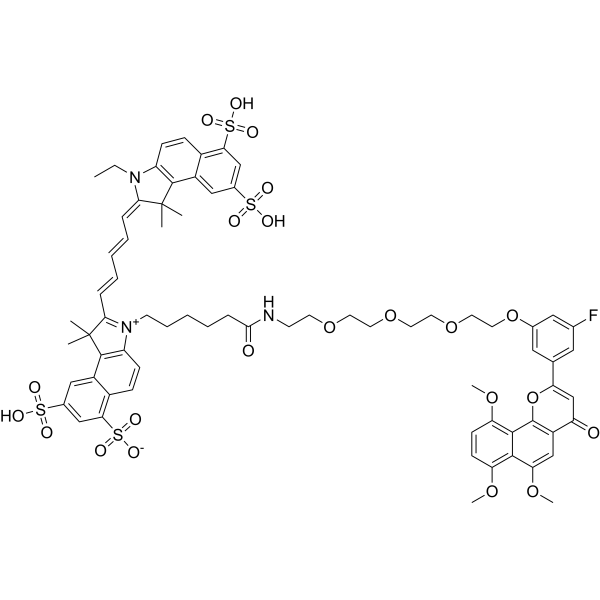
-
- HY-163359
-
|
|
Cytochrome P450
HDAC
|
Cancer
|
|
CYP17A1/HDAC6-IN-1 (compound 12) is a potent inhibitor of CYP17A1/HDAC6, with IC50 of 0.284μM and 0.6015 μM,respectively. CYP17A1/HDAC6-IN-1 has anti-tumor activity .
|
-
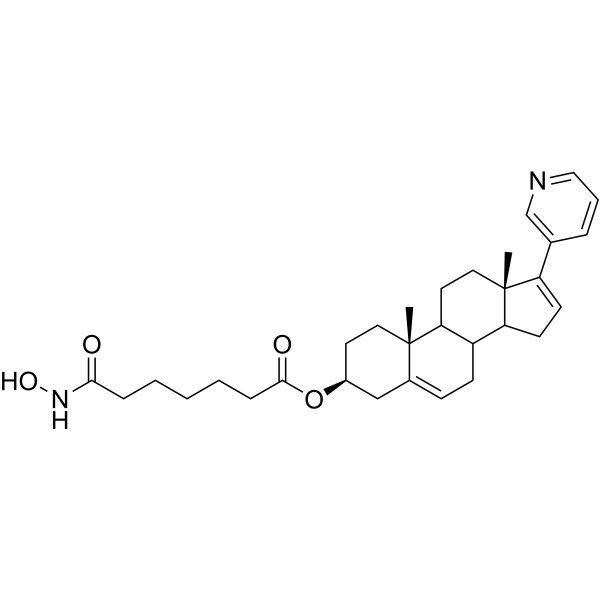
-
- HY-144325
-
|
|
Cytochrome P450
|
Infection
|
|
CYP121A1-IN-1 is a potent CYP121A1 inhibitor with favorable activity against Mycobacterium tuberculosis (H37Rv MIC90∼6.25 μM, ∼2.2 μg/mL). CYP121A1-IN-1 can markedly reduce the production of mycocyclosin via inhibiting the CYP121A1 mediated turnover of cyclo(l-tyrosyl-l-tyrosyl) to mycocyclosin .
|
-

-
- HY-149617
-
|
|
Cytochrome P450
PD-1/PD-L1
|
Infection
|
|
CYP51/PD-L1-IN-4 (compound 14a-2) is a potent dual-target (CYP51/PD-L1) inhibitor, with IC50 values of 0.17 and 0.021 μM, respectively. CYP51/PD-L1-IN-4 exhibits excellent antifungal and antidrug-resistant fungal activity in vitro. CYP51/PD-L1-IN-4 can be used for fungal infections research .
|
-

-
- HY-N0598
-
|
20(S)-Ginsenoside F1
|
Cytochrome P450
Endogenous Metabolite
|
Cancer
|
|
Ginsenoside F1, an enzymatically modified derivative of Ginsenoside Rg1, demonstrates competitive inhibition of CYP3A4 activity and weaker inhibition of CYP2D6 activity.
|
-

-
- HY-N2071
-
Cedrol
1 Publications Verification
(+)-Cedrol; α-Cedrol
|
Cytochrome P450
Fungal
|
Infection
Inflammation/Immunology
Cancer
|
|
Cedrol is a bioactive sesquiterpene, a potent competitive inhibitor of cytochrome P-450 (CYP) enzymes. Cedrol inhibits CYP2B6-mediated bupropion hydroxylase and CYP3A4-mediated midazolam hydroxylation with Ki of 0.9 μM and 3.4 μM, respectively. Cedrol also has weak inhibitory effect on CYP2C8, CYP2C9, and CYP2C19 enzymes . Cedrol is found in cedar essential oil and poetesses anti-septic, anti-inflammatory, anti-spasmodic, tonic, astringent, diuretic, insecticidal, and anti-fungal activities .
|
-
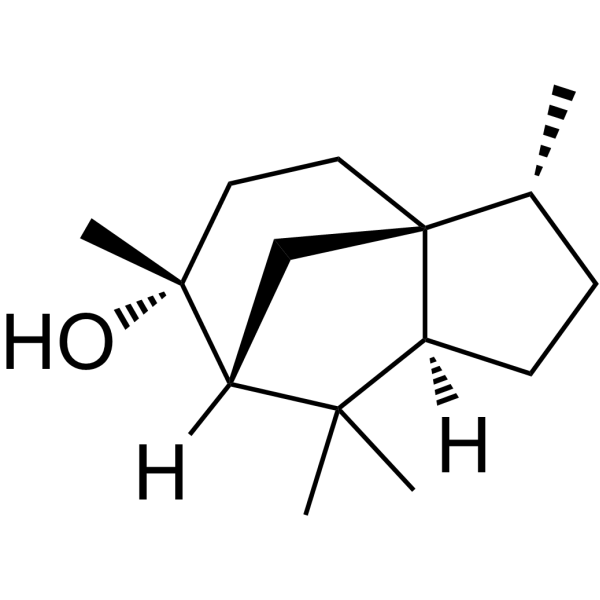
-
- HY-B0822S1
-
|
|
GABA Receptor
Cytochrome P450
|
Inflammation/Immunology
|
|
Fipronil- 13C6 is the 13C-labeled Fipronil. Fipronil is an insecticide that acts as a selective antagonist of insect GABA receptors (IC50s = 30 nM and 1,600 nM for cockroach and rat receptors, respectively). Fipronil also inhibits desensitizing and non-desensitizing glutamate-induced chloride currents in cockroach neurons (IC50s = 800 nM and 10 nM, respectively). Fipronil induces activity of the cytochrome P450 (CYP) isoforms CYP1A1/2, CYP2B1/2, and CYP3A1/2 in isolated rat liver microsomes.
|
-
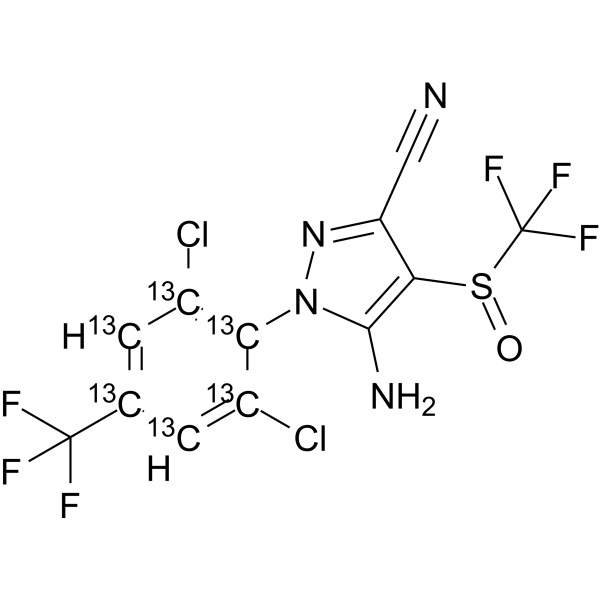
-
- HY-156150
-
|
|
Fungal
Cytochrome P450
PD-1/PD-L1
|
Infection
|
|
CYP51/PD-L1-IN-2 (compound L20) is a quinazoline compound with antifungal activity. CYP51/PD-L1-IN-2 is a dual inhibitor of CYP51 (IC50: 0.263 μM) and PD-L1 (IC50: 0.017 μM), which can induce early apoptosis of fungal cells in the cell cycle. CYP51/PD-L1-IN-2 also significantly reduced intracellular IL-2, NLRP3, and NF-κBp65 protein levels, induced mitochondrial damage and ROS accumulation, and ultimately led to fungal lysis and death .
|
-
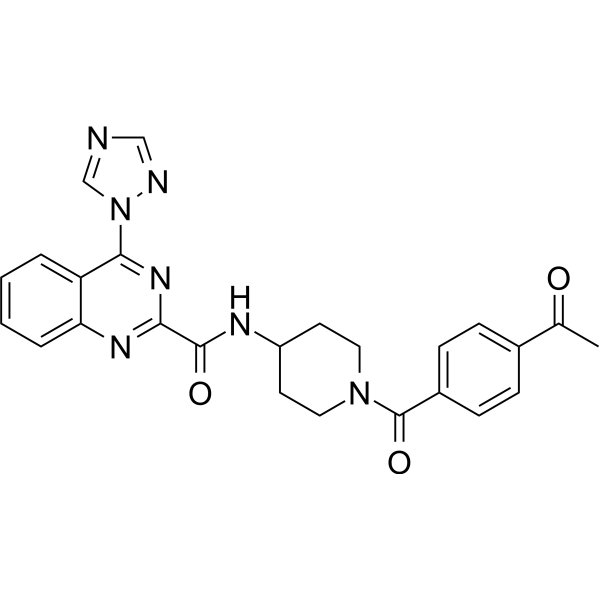
-
- HY-156151
-
|
|
Fungal
Cytochrome P450
PD-1/PD-L1
|
Infection
|
|
CYP51/PD-L1-IN-3 (compound L21) is a quinazoline compound with antifungal activity. CYP51/PD-L1-IN-3 is a dual inhibitor of CYP51 (IC50: 0.205 μM) and PD-L1 (IC50: 0.039 μM), which can induce early apoptosis of fungal cells in the cell cycle. CYP51/PD-L1-IN-3 also significantly reduced intracellular IL-2, NLRP3, and NF-κBp65 protein levels, induced mitochondrial damage and ROS accumulation, and ultimately led to fungal lysis and death .
|
-

-
- HY-156149
-
|
|
Fungal
Cytochrome P450
PD-1/PD-L1
|
Infection
|
|
CYP51/PD-L1-IN-1 (compound L11) is a quinazoline compound with antifungal activity. CYP51/PD-L1-IN-1 is a dual inhibitor of CYP51 (IC50: 0.884 μM) and PD-L1 (IC50: 0.083 μM), which can induce early apoptosis of fungal cells in the cell cycle. CYP51/PD-L1-IN-1 also significantly reduced intracellular IL-2, NLRP3, and NF-κBp65 protein levels, induced mitochondrial damage and ROS accumulation, and ultimately led to fungal lysis and death .
|
-
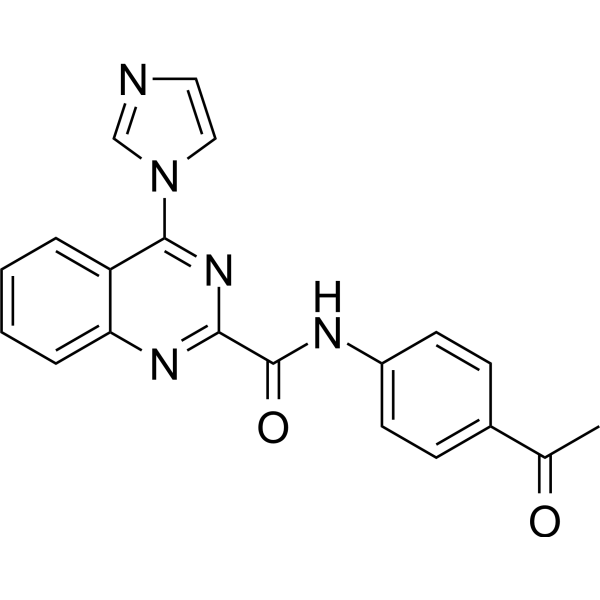
-
- HY-135331
-
|
|
Androgen Receptor
Cytochrome P450
|
Cancer
|
|
N-Desmethyl Apalutamide is an active metabolite of Apalutamide. N-Desmethyl Apalutamide is a less potent antagonist of the androgen receptor and is responsible for one-third of the activity of Apalutamide. The formation of N-Desmethyl Apalutamide mediated predominantly by CYP2C8 and CYP3A4. N-Desmethyl Apalutamide is moderate to strong CYP3A4 and CYP2B6 inducer and has an excellent plasma-proteins bound concentration .
|
-
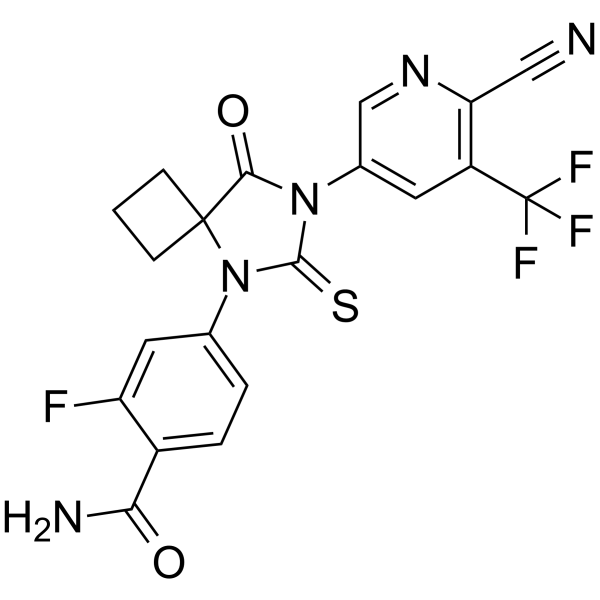
-
- HY-70013
-
Abiraterone
Maximum Cited Publications
17 Publications Verification
CB-7598
|
Cytochrome P450
|
Cancer
|
|
Abiraterone is a potent and irreversible CYP17A1 inhibitor with antiandrogen activity, which inhibits both the 17α-hydroxylase and 17,20-lyase activity of the cytochrome p450 enzyme CYP17 with IC50s of 2.5 nM and 15 nM, respectively.
|
-
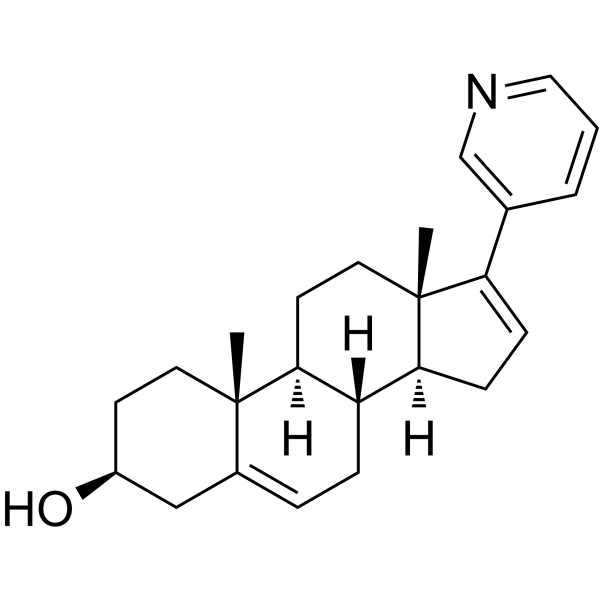
-
- HY-128920
-
|
|
Cytochrome P450
|
Cancer
|
|
Phortress free base (NSC 710305) is a P450 CYP1A1-activated antitumor prodrug with antitumor activity . Phortress free base leads to DNA damage and cell cycle arrest .
|
-
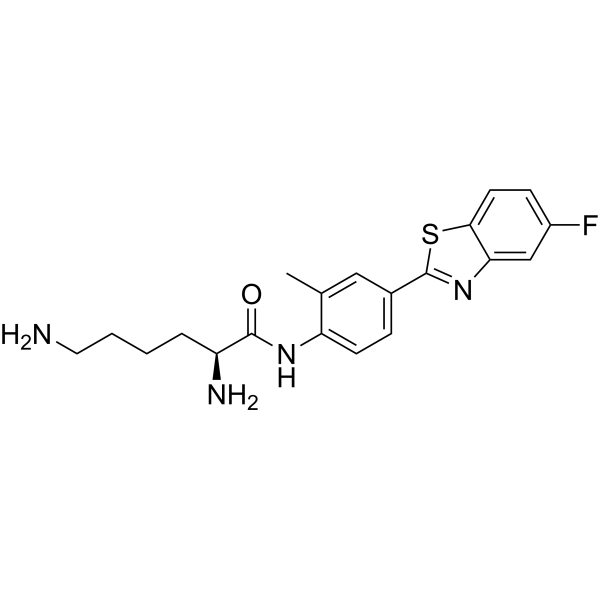
-
- HY-100665
-
|
OPC-14857; DM-14857
|
5-HT Receptor
|
Neurological Disease
|
|
Dehydroaripiprazole (OPC-14857) is an active metabolite of Aripiprazole. Aripiprazole is an antipsychotic agent and is metabolized by CYP3A4 and CYP2D6 forming mainly Dehydroaripiprazole. Dehydroaripiprazole has with antipsychotic activity equivalent to Aripiprazole .
|
-
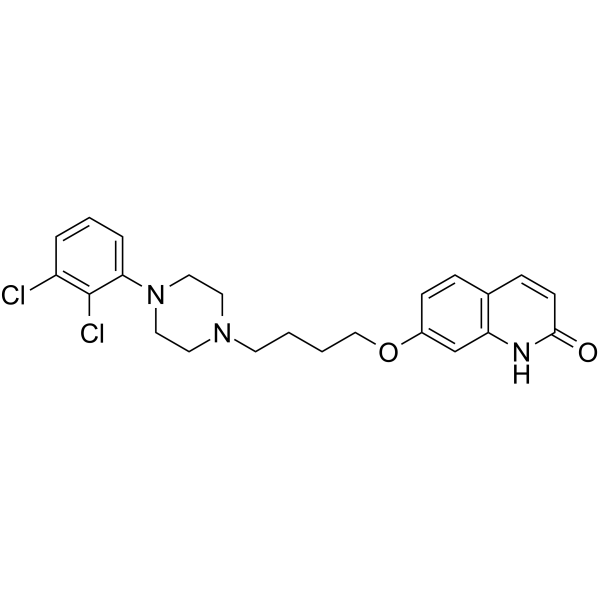
-
- HY-148595
-
|
|
Cytochrome P450
|
Cancer
|
|
Antitumor agent-88 exhibits potent antimitotic activity and arrests cell in the G2/M phase. Antitumor agent-88 disrupts the microtubule and the cytoskeleton in CYP1A1-expressing breast cancer cells. Antitumor agent-88 is also a competitive inhibitor of CYP1A1 (Ki: 1.4 μM) .
|
-
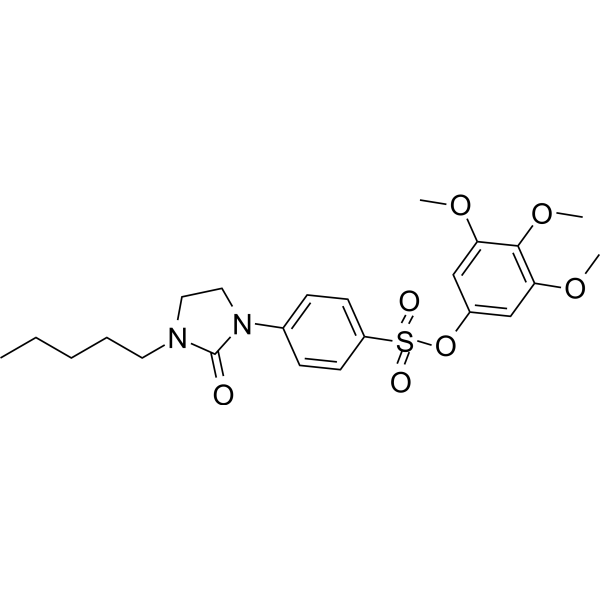
-
- HY-W019847
-
|
|
Cytochrome P450
|
Infection
Metabolic Disease
|
|
Azamulin is an irreversible, highly selective inhibitior of human CYP3Aa. Azamulin has CYP3A inhibition activity with IC50 values range from 0.03-0.24 μM. Azamulin can be used for the research of metabolism and antiinfection .
|
-

-
- HY-113575
-
|
OPC-14857 hydrochloride; DM-14857 hydrochloride
|
5-HT Receptor
|
Neurological Disease
|
|
Dehydroaripiprazole (OPC-14857) hydrochloride is an active metabolite of Aripiprazole. Aripiprazole is an antipsychotic agent and is metabolized by CYP3A4 and CYP2D6 forming mainly Dehydroaripiprazole hydrochloride. Dehydroaripiprazole hydrochloride has with antipsychotic activity equivalent to Aripiprazole .
|
-
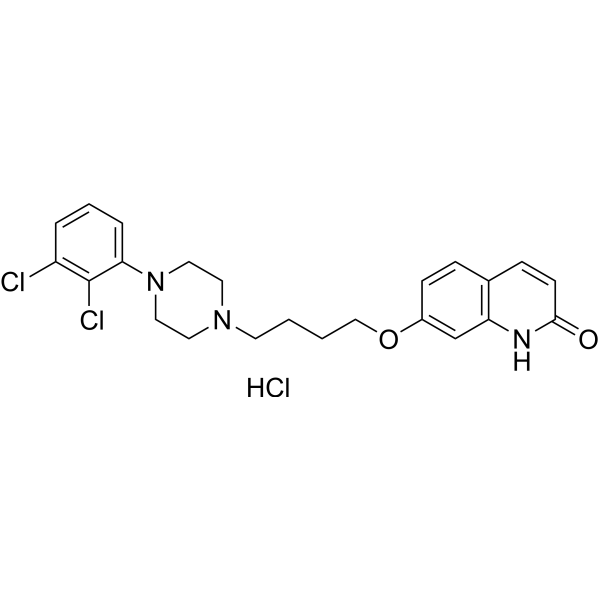
-
- HY-N0693
-
-
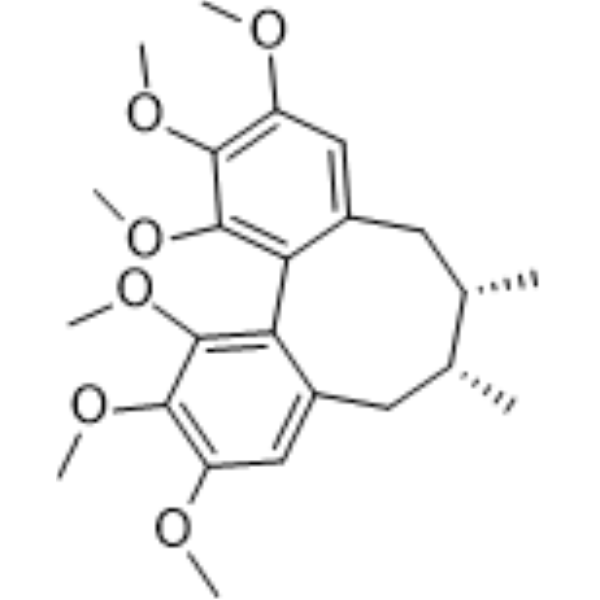
-
- HY-119804
-
|
|
Cytochrome P450
|
Neurological Disease
|
|
Licopyranocoumarin is an isoflavonoid that shows CYP3A4 inhibitory activity with an IC50 of 32 μM. Licopyranocoumarin has potent neuroprotective activities .
|
-

-
- HY-70013S
-
|
CB-7598-d4
|
Cytochrome P450
|
Cancer
|
|
Abiraterone-d4 is the deuterium labeled Abiraterone. Abiraterone is a potent and irreversible CYP17A1 inhibitor with antiandrogen activity, which inhibits both the 17α-hydroxylase and 17,20-lyase activity of the cytochrome p450 enzyme CYP17 with IC50s of 2.5 nM and 15 nM, respectively.
|
-

-
- HY-10882
-
-
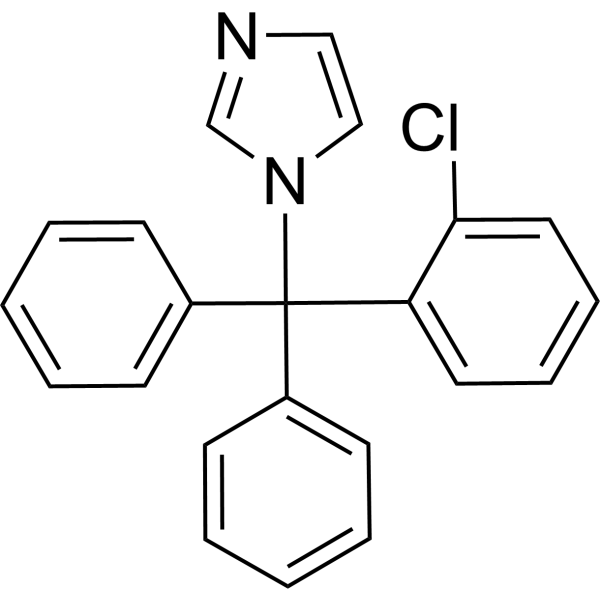
-
- HY-122277
-
-

-
- HY-W754151
-
|
|
Isotope-Labeled Compounds
|
Others
|
|
N-Desmethyl apalutamide-d4 is the deuterium-labeled N-Desmethyl-Apalutamide (HY-135331). N-Desmethyl Apalutamide is an active metabolite of Apalutamide. N-Desmethyl Apalutamide is a less potent antagonist of the androgen receptor and is responsible for one-third of the activity of Apalutamide. The formation of N-Desmethyl Apalutamide mediated predominantly by CYP2C8 and CYP3A4. N-Desmethyl Apalutamide is moderate to strong CYP3A4 and CYP2B6 inducer and has an excellent plasma-proteins bound concentration .
|
-
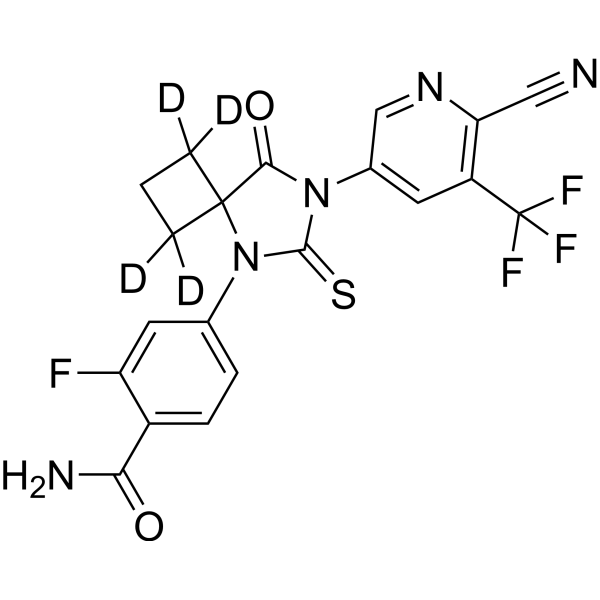
-
- HY-19340
-
TMS
5 Publications Verification
(E)-2,3',4,5'-tetramethoxystilbene
|
Cytochrome P450
|
Cancer
|
|
TMS ((E)-2,3',4,5'-tetramethoxystilbene) is a selective and competitive CYP1B1 inhibitor with an IC50 of 6 nM and a Ki value of 3 nM. TMS shows a lesser extent inhibitory effect on CYP1A1 (IC50=300 nM) and CYP1A2 (IC50=3.1 μM). TMS is a methylated derivative of resveratrol and has anti-cancer activity .
|
-

-
- HY-W010195
-
|
|
Cytochrome P450
|
Others
|
|
2,6-Dimethylquinoline, a nature constituent from the roots of Peucedantu praeruptorum, is a CYP1A2 inhibitor with an IC50 of 3.3 µM. 2,6-Dimethylquinoline also inhibits CYP2B6 activity with an IC50 of 480 µM .
|
-
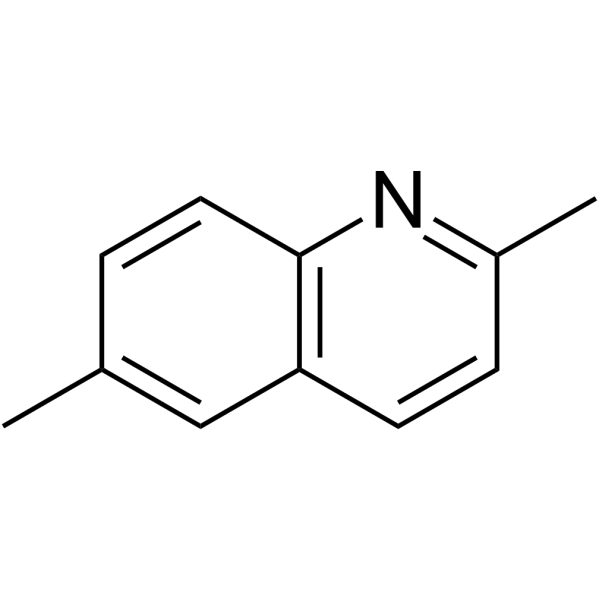
-
- HY-120425
-
|
|
Others
|
Infection
|
|
Ethiprole is an insecticide.Metabolic sulfones are produced faster than Fipronil (HY-B0822) in CYP3A4-expressing cells and in vivo in mouse brain and liver.Ethiprole's sulfide, sulfoxide, sulfone and desulfinyl derivatives have better biological activity .
|
-
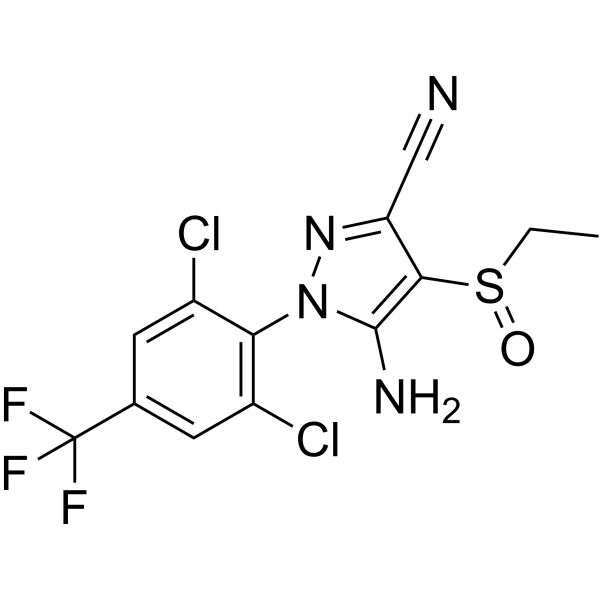
-
- HY-N0921
-
|
(+)-Dihydromethysticin
|
Cytochrome P450
|
Inflammation/Immunology
|
|
Dihydromethysticin is one of the six major kavalactones found in the kava plant; has marked activity on the induction of CYP3A23.
|
-
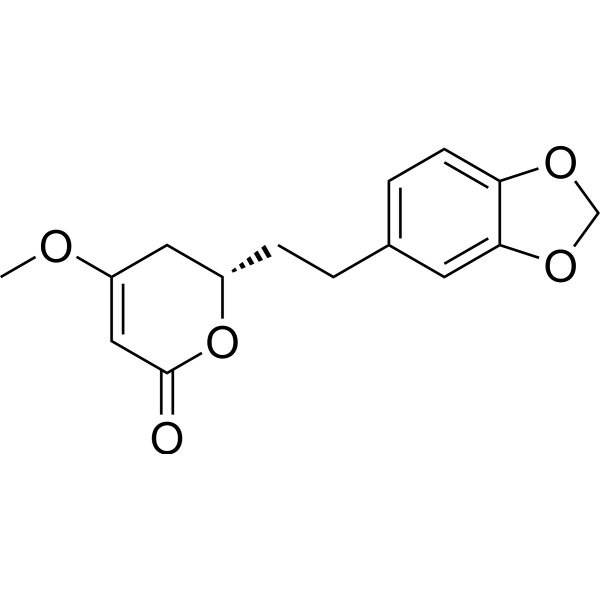
-
- HY-103223
-
|
NSC 710305
|
Cytochrome P450
|
Cancer
|
|
Phortress is a high affinity AhR ligand that elicits antitumor activity by inducing transcription of CYP1A1 .
|
-
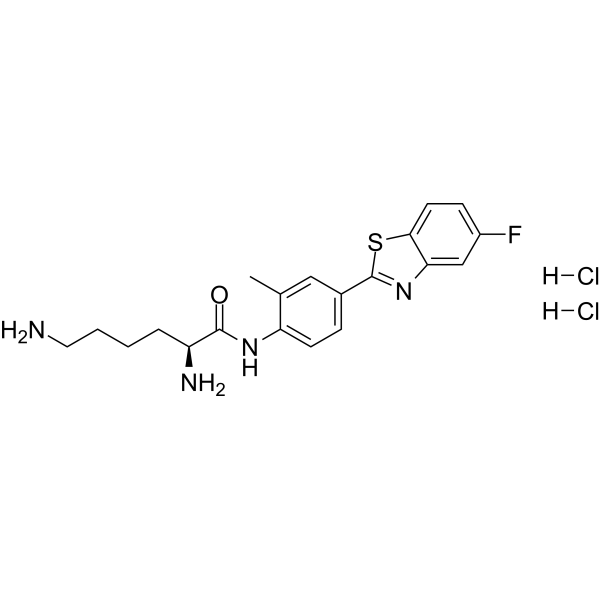
-
- HY-W011235
-
|
|
5-HT Receptor
Calcium Channel
Drug Metabolite
|
Neurological Disease
|
|
Norfluoxetine hydrochloride is an active N-demethylated metabolite of Fluoxetine. Fluoxetine is a selective serotonin (5-HT) reuptake inhibitor that is metabolized to Norfluoxetine hydrochloride by cytochrome P450 (CYP) 2D6, CYP2C19, and CYP3A4. Norfluoxetine hydrochloride inhibits 5-HT uptake and inhibits CaV3.3 T current (IC50 = 5 μM). Norfluoxetine hydrochloride has anticonvulsant activity .
|
-

-
- HY-163324A
-
|
|
Cytochrome P450
|
Others
|
|
2-Me PeER is a rhodamine dye-based fluorescent probe that detects CYP3A4 activity. In fluorescence-activated cell sorting (FACS) based on CYP3A4 activity, homogeneous and functional human induced pluripotent stem cell (hiPSC)-derived hepatocytes and intestinal epithelial cells can be obtained with the aid of 2-Me PeER .
|
-

-
- HY-12946A
-
|
|
|
|
|
BI 653048 phosphate is a selective and orally active nonsteroidal glucocorticoid (GC) agonist with an IC50 value of 55 nM . BI 653048 phosphate inhibits CP1A2, CYP2D6, CYP2C9, CYP2C19 and CYP3A4 isoforms’ activity and reduces affinity for the hERG ion channel (IC50>30 μM) . BI 653048 phosphate is extracted from patent WO2005028501A1 (Compound 103), is also a HCV NS3 protease inhibitor that can reduce viral loads infected with the hepatitis C virus .
|
-
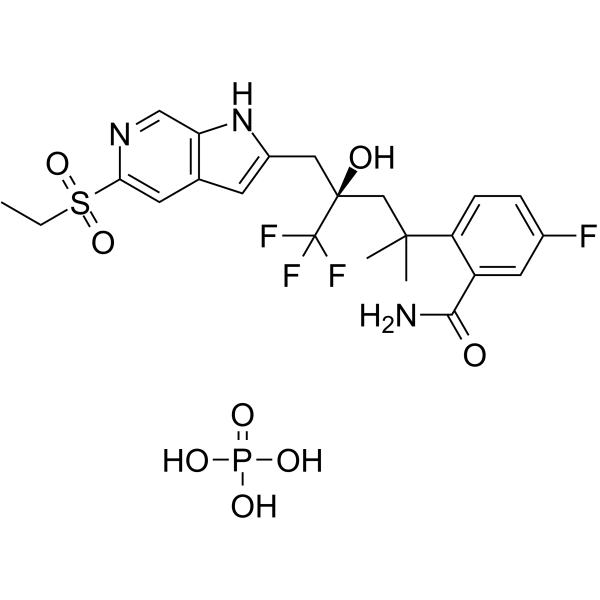
-
- HY-12946
-
|
|
|
|
|
BI 653048 is a selective and orally active nonsteroidal glucocorticoid (GC) agonist with an IC50 value of 55 nM . BI 653048 inhibits CP1A2, CYP2D6, CYP2C9, CYP2C19 and CYP3A4 isoforms’ activity and reduces affinity for the hERG ion channel (IC50>30 μM) . BI 653048 is extracted from patent WO2005028501A1 (Compound 103), is also a HCV NS3 protease inhibitor that can reduce viral loads infected with the hepatitis C virus .
|
-
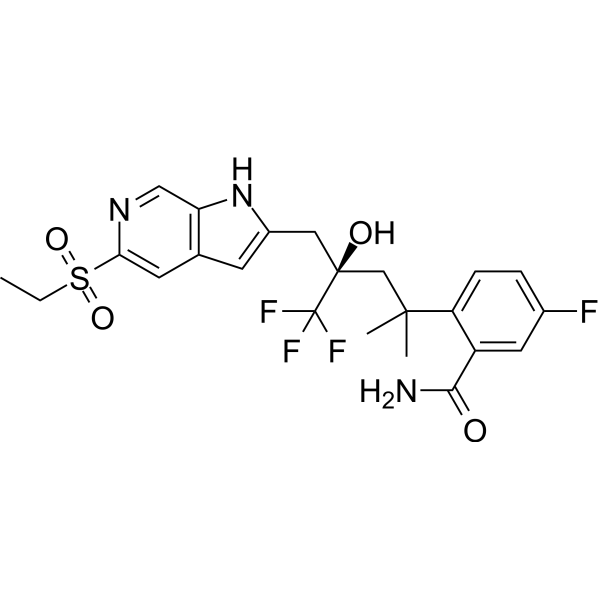
-
- HY-17643
-
|
VT-1161
|
|
|
|
Oteseconazole (VT-1161) is a potent and orally active anti-fungal agent. Oteseconazole potently binds to and inhibits Candida albicans cytochrome P45051 (CYP51) activity (Kd ≤39 nM), shows no obvious effect on human CYP51. Oteseconazole also can be used for the research of dermatophytes .
|
-
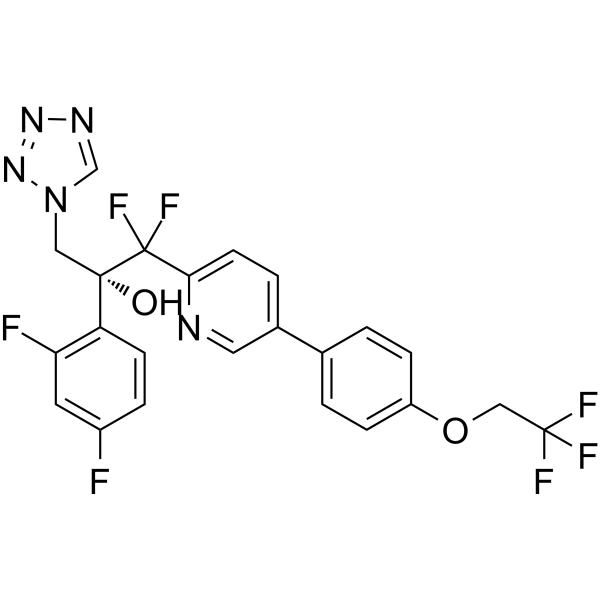
-
- HY-N0125
-
|
|
Cytochrome P450
|
Cancer
|
|
Diosmetin is a natural flavonoid which inhibits human CYP1A enzyme activity with an IC50 of 40 μM in HepG2 cell.
|
-

-
- HY-14874
-
|
FYX-051
|
Xanthine Oxidase
Cytochrome P450
|
Metabolic Disease
|
|
Topiroxostat (FYX-051) is a potent and orally active xanthine oxidoreductase (XOR) inhibitor with an IC50 value of 5.3 nM and a Ki value of 5.7 nM. Topiroxostat exhibits weak CYP3A4-inhibitory activity (18.6%). Topiroxostat has the potential for hyperuricemia treatment .
|
-

-
- HY-100665S
-
|
OPC-14857-d8; DM-14857-d8
|
Isotope-Labeled Compounds
5-HT Receptor
|
Neurological Disease
|
|
Dehydroaripiprazole-d8 is deuterium labeled Dehydroaripiprazole. Dehydroaripiprazole (OPC-14857) is an active metabolite of Aripiprazole. Aripiprazole is an antipsychotic agent and is metabolized by CYP3A4 and CYP2D6 forming mainly Dehydroaripiprazole. Dehydroaripiprazole has with antipsychotic activity equivalent to Aripiprazole[1][2][3].
|
-
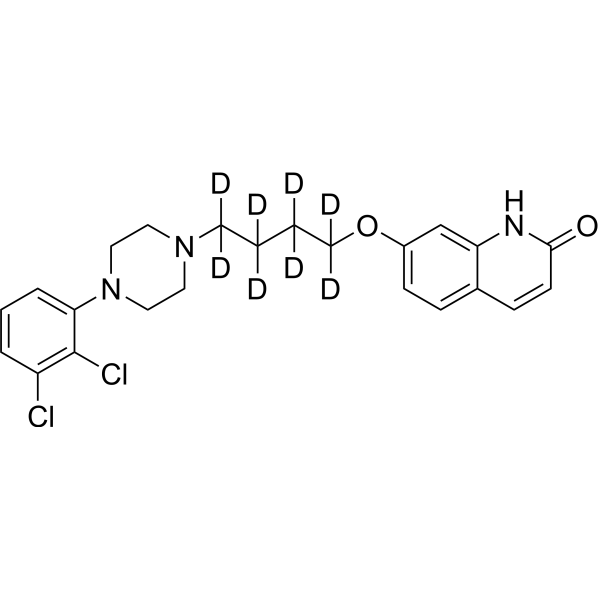
-
- HY-N0043
-
-
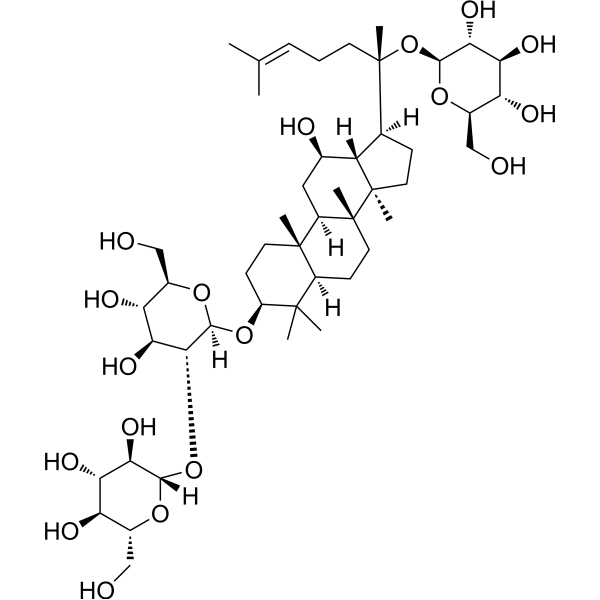
-
- HY-N0382
-
|
Norizalpinin; 3,5,7-Trihydroxyflavone
|
Cytochrome P450
Autophagy
|
Cancer
|
|
Galangin (Norizalpinin) is an agonist/antagonist of the arylhydrocarbon receptor. Galangin (Norizalpinin) also shows inhibition of CYP1A1 activity.
|
-
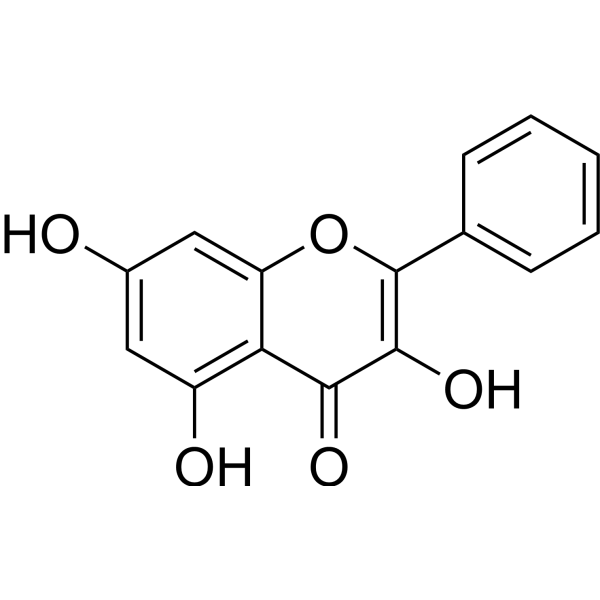
-
- HY-148375
-
|
|
Drug Metabolite
|
Others
|
|
Abiraterone sulfate is a metabolite of Abiraterone (HY-148377). Abiraterone is a potent and irreversible CYP17A1 inhibitor with antiandrogen activity .
|
-
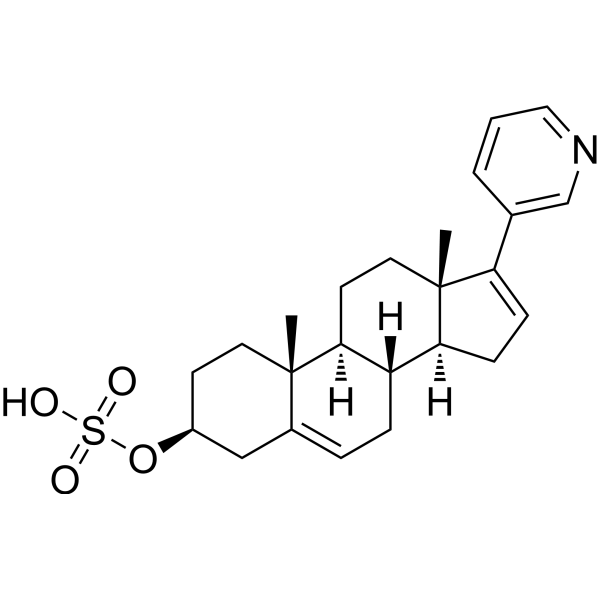
-
- HY-100665R
-
|
OPC-14857 (Standard); DM-14857 (Standard)
|
5-HT Receptor
|
Neurological Disease
|
|
Dehydroaripiprazole (Standard) is the analytical standard of Dehydroaripiprazole. This product is intended for research and analytical applications. Dehydroaripiprazole (OPC-14857) is an active metabolite of Aripiprazole. Aripiprazole is an antipsychotic agent and is metabolized by CYP3A4 and CYP2D6 forming mainly Dehydroaripiprazole. Dehydroaripiprazole has with antipsychotic activity equivalent to Aripiprazole .
|
-
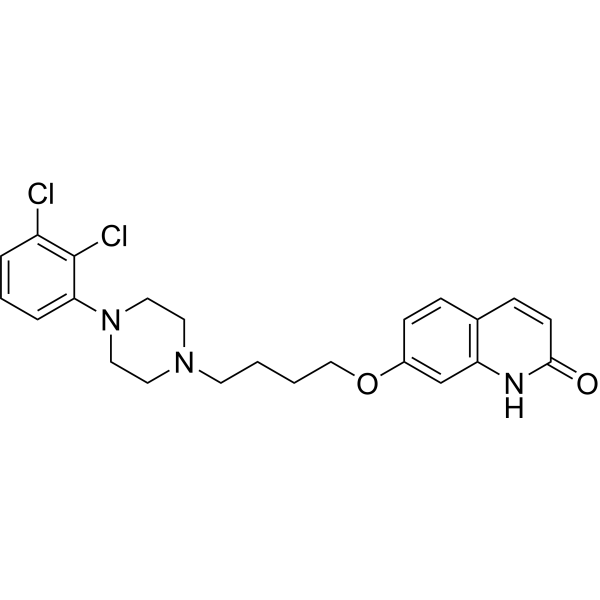
-
- HY-13463BS
-
|
AKR-501-d8 hydrochloride; E5501-d8 hydrochloride; YM477-d8 hydrochloride
|
Isotope-Labeled Compounds
Thrombopoietin Receptor
|
Cardiovascular Disease
|
|
Avatrombopag-d8 (hydrochloride) is deuterium labeled Avatrombopag (hydrochloride). Avatrombopag (AKR-501) hydrochloride is an orally active, nonpeptide thrombopoietin (TPO) receptor agonist (EC50=3.3 nM). Avatrombopag hydrochloride mimics the biological activities of TPO. Avatrombopag hydrochloride increases platelet production by activating the intracellular signaling system, and promotes production of platelets and megakaryocytes from hemopoietic precursor cells. Avatrombopag hydrochloride is a substrate of cytochrome P450 (CYP) 2C9 and CYP3A[1][2][3].
|
-

-
- HY-100901
-
|
|
Cytochrome P450
|
Metabolic Disease
|
|
CDD3505 is used for elevating high density lipoprotein cholesterol (HDL) by inducing hepatic cytochrome P450IIIA (CYP3A) activity.
|
-
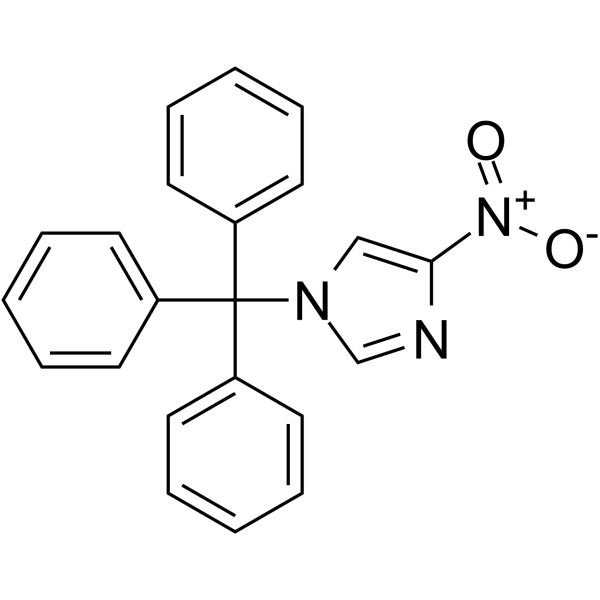
-
- HY-100902
-
|
|
Cytochrome P450
|
Metabolic Disease
|
|
CDD3506 is used for elevating high density lipoprotein cholesterol (HDL) by inducing hepatic cytochrome P450IIIA (CYP3A) activity.
|
-
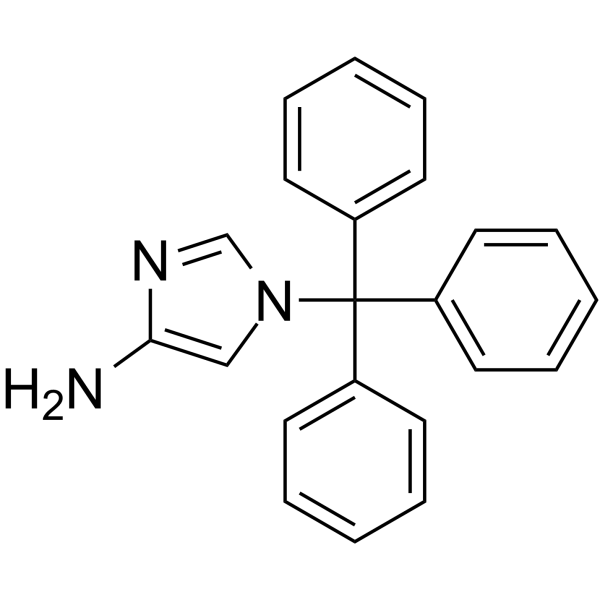
- HY-148376
-
|
|
Drug Metabolite
|
Cancer
|
|
Abiraterone N-oxide is a metabolite of Abiraterone (HY-148377). Abiraterone is a potent and irreversible CYP17A1 inhibitor with antiandrogen activity .
|
-
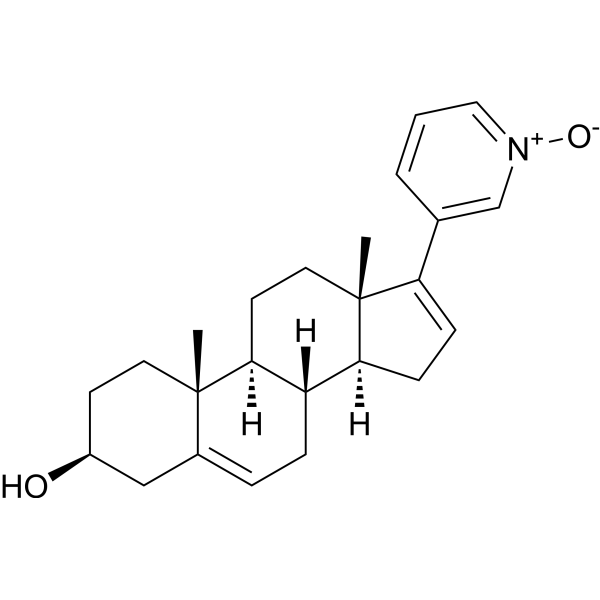
- HY-149769
-
|
|
Others
|
Cancer
|
|
CP-506 (compound 26) is an anticancer compound and a substrate for nitroreductase and CYP oxidoreductases. CP-506 has anticancer activity .
|
-

- HY-121580
-
|
NN703
|
Cytochrome P450
|
Endocrinology
|
|
Tabimorelin (NN703) is an orally active growth hormone (GH) secretagogue. Tabimorelin is also a potent inhibitor of CYP3A4 activity .
|
-
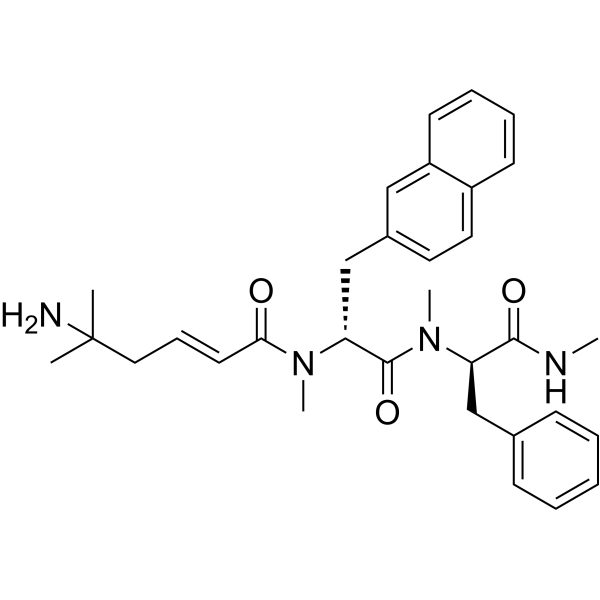
- HY-117766
-
|
|
Fungal
Cytochrome P450
|
Infection
|
|
PC945, a potent, long-acting antifungal triazole, possesses activity against a broad range of both azole-susceptible and azole-resistant strains of Aspergillus fumigatus. PC945 is also a potent, tightly binding inhibitor of A. fumigatus sterol 14α-demethylase activity, CYP51A and CYP51B, with IC50s of 0.23 μM and 0.22 μM, respectively .
|
-
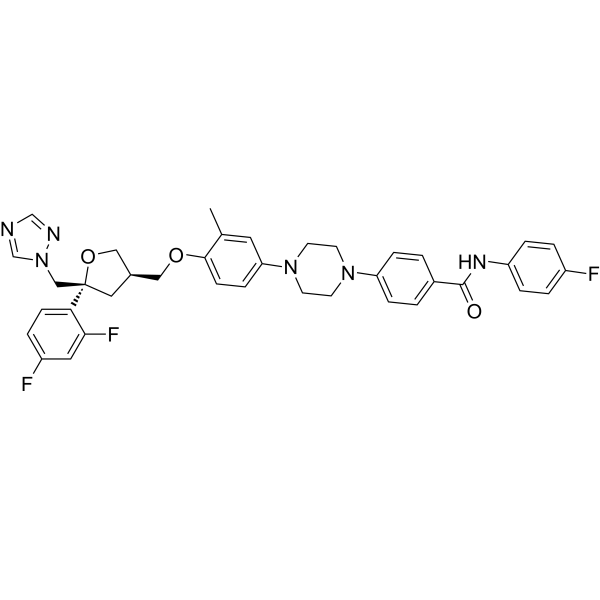
- HY-75054
-
|
CB7630
|
Cytochrome P450
|
Cancer
|
|
Abiraterone acetate (CB7630) is an oral, potent, selective, and irreversible inhibitor of CYP17A1 with antiandrogen activity. Abiraterone acetate is a proagent form of Abiraterone (CB7598).
|
-
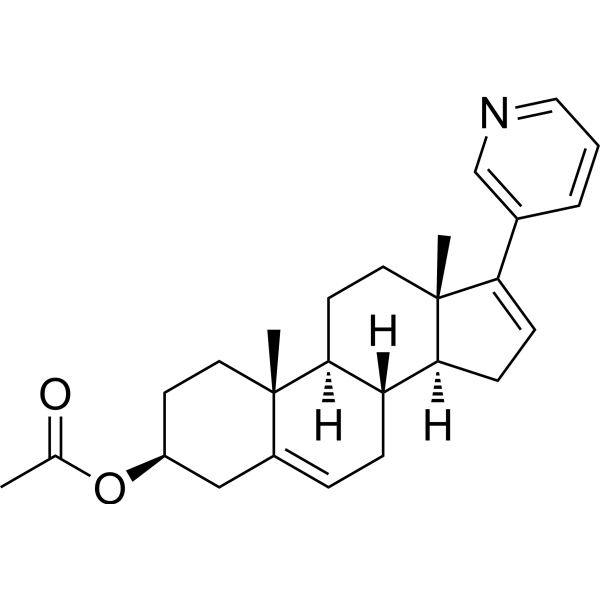
- HY-163324
-
|
|
Fluorescent Dye
|
Others
|
|
2-Me PeER (chloride) is a fluorogenic probe for CYP3A4 activity that can be used in living cells . Ex / Em = 520 / 550 nm
|
-
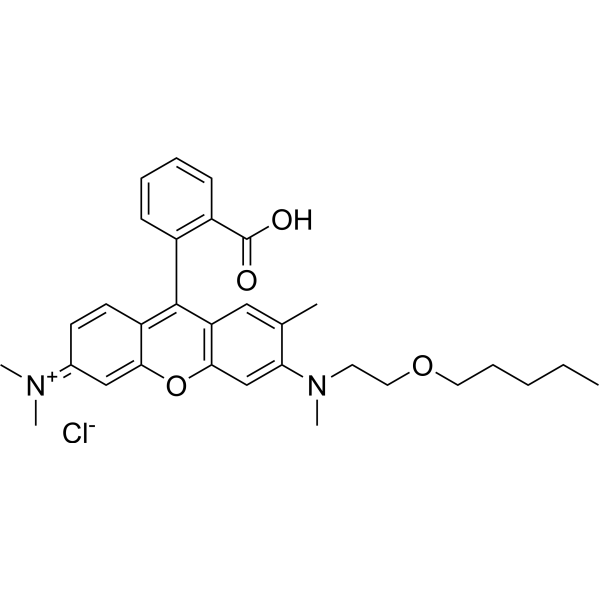
- HY-10882S
-
-
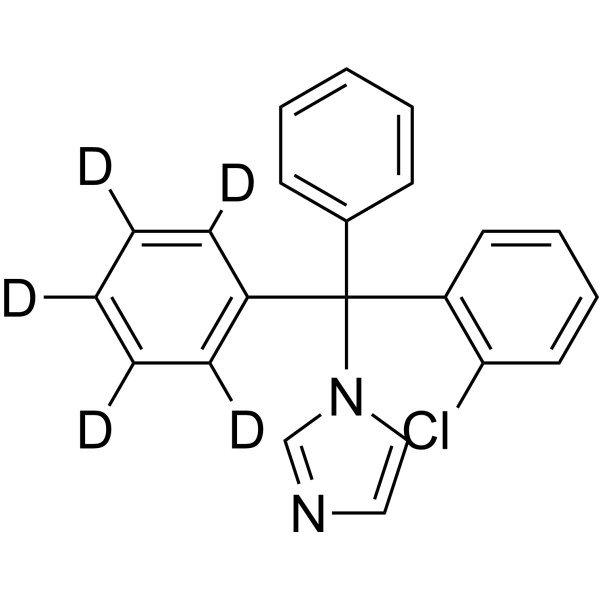
- HY-103540
-
|
NN703 hemifumarate
|
Cytochrome P450
|
Endocrinology
|
|
Tabimorelin (NN703) hemifumarate is an orally active growth hormone (GH) secretagogue. Tabimorelin hemifumarate is also a potent inhibitor of CYP3A4 activity .
|
-
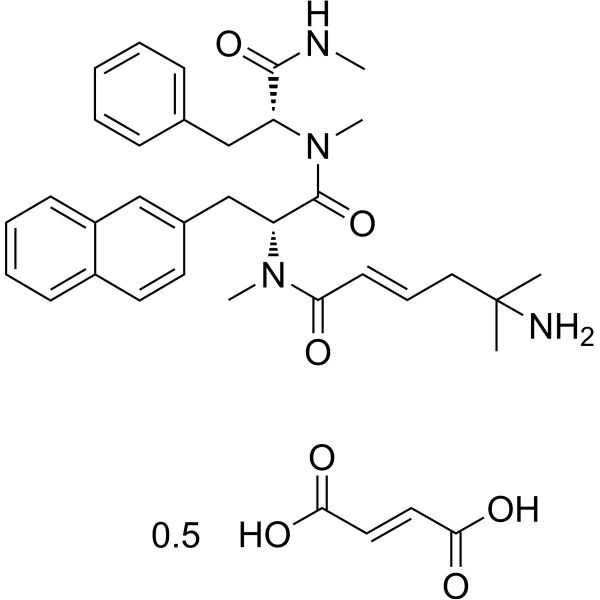
- HY-N0043R
-
|
Gypenoside VIII (Standard)
|
NF-κB
COX
Calcium Channel
Cytochrome P450
Endogenous Metabolite
|
Cardiovascular Disease
Inflammation/Immunology
Cancer
|
|
Ginsenoside Rd (Standard) is the analytical standard of Ginsenoside Rd. This product is intended for research and analytical applications. Ginsenoside Rd inhibits TNFα-induced NF-κB transcriptional activity with an IC50 of 12.05±0.82 μM in HepG2 cells. Ginsenoside Rd inhibits expression of COX-2 and iNOS mRNA. Ginsenoside Rd also inhibits Ca 2+ influx. Ginsenoside Rd inhibits CYP2D6, CYP1A2, CYP3A4, and CYP2C9, with IC50s of 58.0±4.5 μM, 78.4±5.3 μM, 81.7±2.6 μM, and 85.1±9.1 μM, respectively.
|
-

- HY-17508
-
|
|
Bacterial
Cytochrome P450
Autophagy
Antibiotic
|
Infection
Cancer
|
|
Clarithromycin has a broad spectrum of antimicrobial activity. Clarithromycin inhibits the CYP3A4-catalyzed triazolam alpha-hydroxylation with the IC50 (Ki) value of 56 (43) μM . Clarithromycin significantly inhibits the HERG potassium current .Clarithromycin affects the autophagic flux by impairing the signaling pathway linking hERG1 and PI3K .
|
-
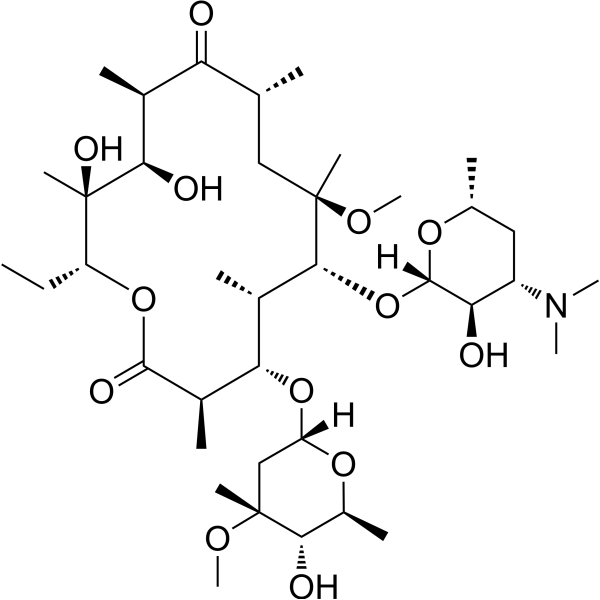
- HY-N2425
-
|
|
Cholinesterase (ChE)
|
Metabolic Disease
|
|
Rhodiosin is a double inhibitor of CYP2D6 and AChE, and can be isolated from Rhodiolis rhodiolis root. The IC50 for CYP2D6 is 0.761 μM, and the Ki is 0.769 μM. Rhodiosin has antioxidant and neuroprotective activity and can regulate HIF-1α signaling pathway to protect the central nervous system
|
-
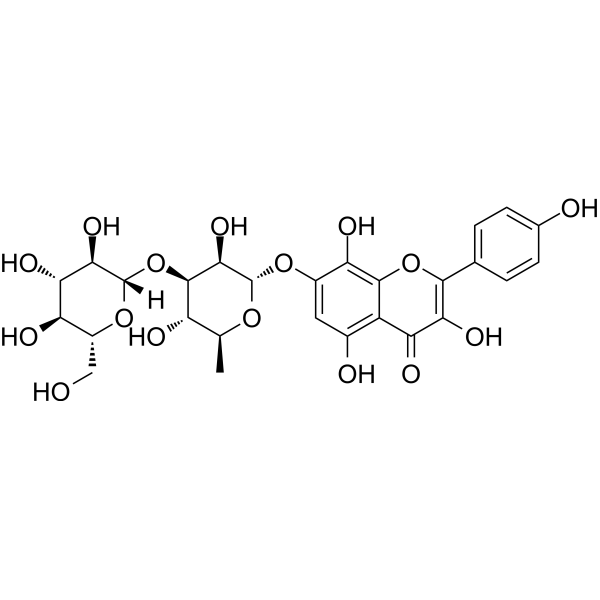
- HY-14874S
-
|
FYX-051-d4
|
Isotope-Labeled Compounds
Xanthine Oxidase
Cytochrome P450
|
Metabolic Disease
|
|
Topiroxostat-d4 is deuterium labeled Topiroxostat. Topiroxostat (FYX-051) is a potent and orally active xanthine oxidoreductase (XOR) inhibitor with an IC50 value of 5.3 nM and a Ki value of 5.7 nM. Topiroxostat exhibits weak CYP3A4-inhibitory activity (18.6%). Topiroxostat has the potential for hyperuricemia treatment[1][2].
|
-
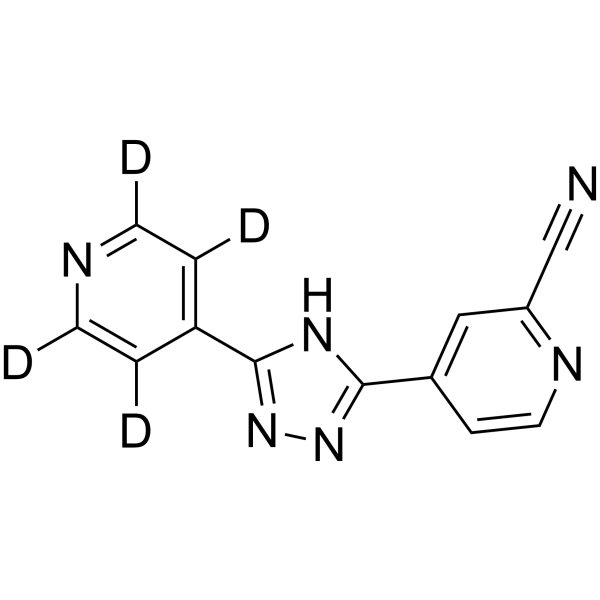
- HY-N0904
-
|
Ginsenoside compound K; Ginsenoside K
|
COX
NO Synthase
Cytochrome P450
|
Inflammation/Immunology
|
|
Ginsenoside C-K, a bacterial metabolite of G-Rb1, exhibits anti-inflammatory effects by reducing iNOS and COX-2. Ginsenoside C-K exhibits an inhibition against the activity of CYP2C9 and CYP2A6 in human liver microsomes with IC50s of 32.0±3.6 μM and 63.6±4.2 μM, respectively.
|
-
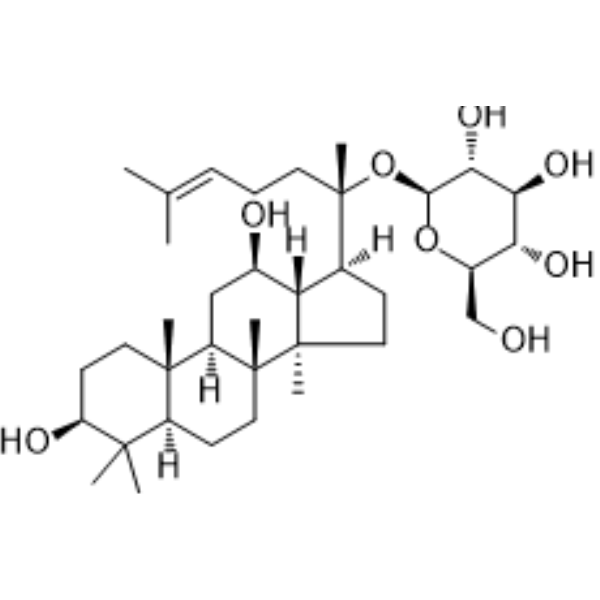
- HY-W008364
-
|
|
Cytochrome P450
Cannabinoid Receptor
|
Neurological Disease
|
|
Olivetol is a naturally phenol found in lichens and produced by certain insects, acting as a competitive inhibitor of the cannabinoid receptors CB1 and CB2 . Olivetol also inhibits CYP2C19 and CYP2D6 activity, with IC50s of 15.3 μM, 7.21 μM and Kis of 2.71 μM, 2.87 μM, respectively .
|
-
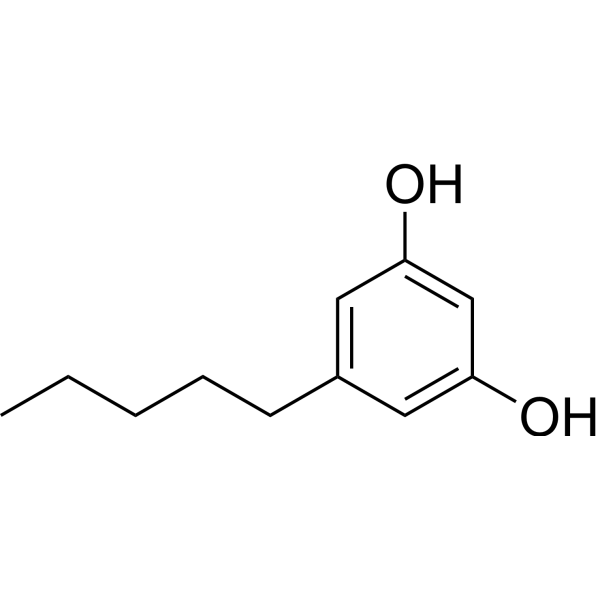
- HY-137193
-
|
|
Drug Metabolite
|
Cancer
|
|
5,6-Dihydroabiraterone is the metabolism of Abiraterone (HY-70013). Abiraterone is a potent and irreversible CYP17A1 inhibitor with antiandrogen activity, and shows antitumor activity in CRPC (castration-resistant prostate cancer) .
|
-
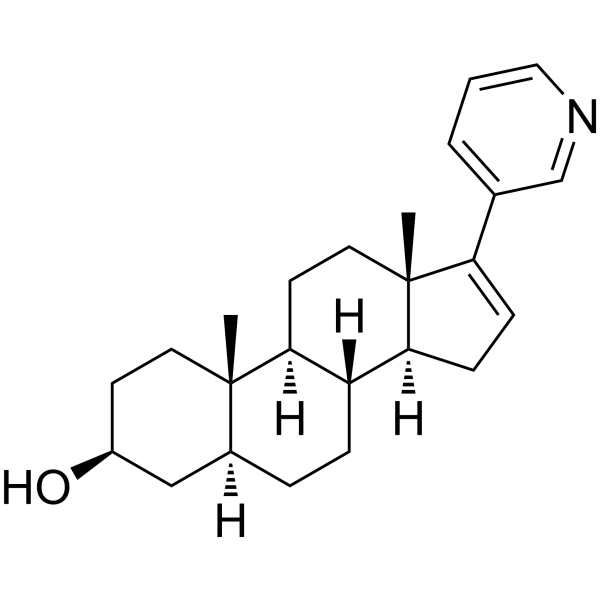
- HY-N0144
-
-
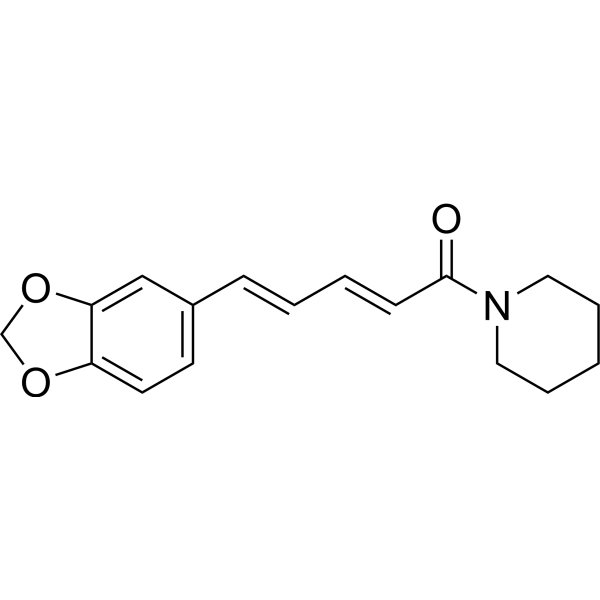
- HY-N0125S
-
-
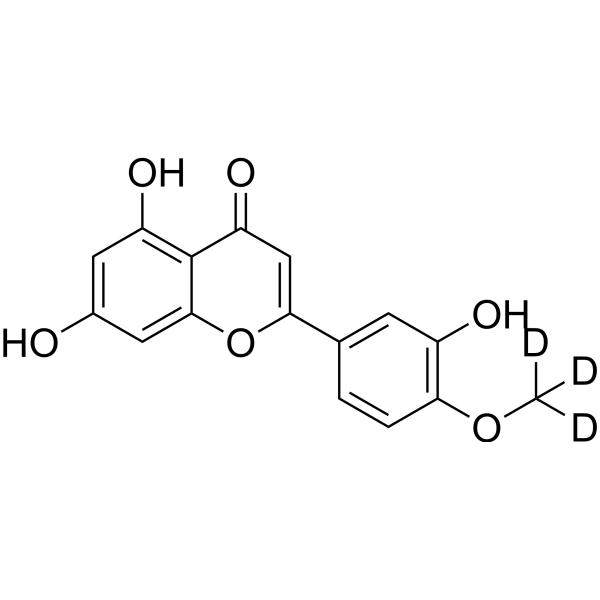
- HY-D0144
-
|
Methoxyresorufin
|
Cytochrome P450
|
Others
|
|
Resorufin methyl ether (Methoxyresorufin) is a cytochrome P450 fluorometric substrate . Resorufin methyl ether is a relatively specific substrate for CYP1A2 activity in rodents .
|
-
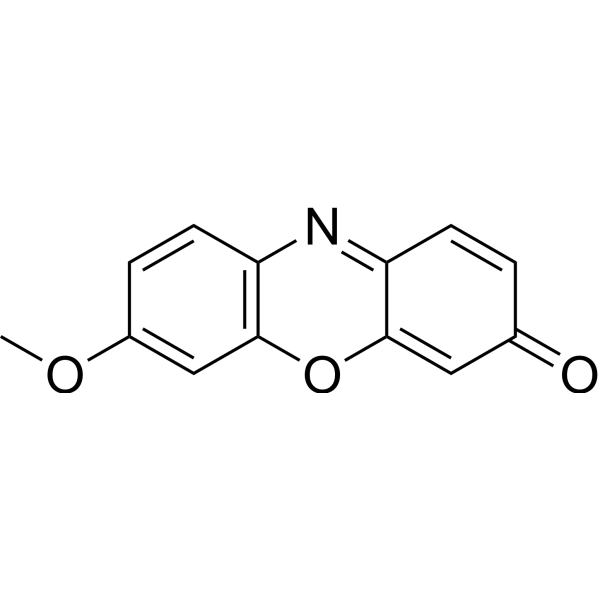
- HY-13463B
-
|
AKR-501 hydrochloride; E5501 hydrochloride; YM477 hydrochloride
|
Thrombopoietin Receptor
|
Cardiovascular Disease
|
|
Avatrombopag (AKR-501) hydrochloride is an orally active, nonpeptide thrombopoietin (TPO) receptor agonist (EC50=3.3 nM). Avatrombopag hydrochloride mimics the biological activities of TPO. Avatrombopag hydrochloride increases platelet production by activating the intracellular signaling system, and promotes production of platelets and megakaryocytes from hemopoietic precursor cells. Avatrombopag hydrochloride is a substrate of cytochrome P450 (CYP) 2C9 and CYP3A .
|
-
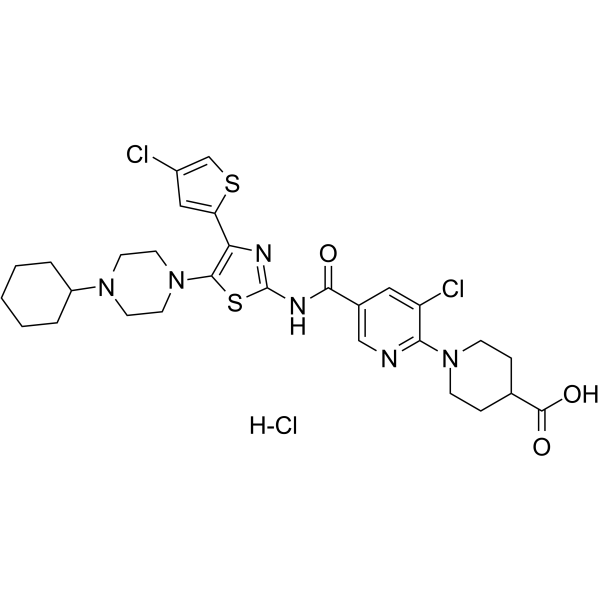
- HY-13463
-
|
AKR-501; E5501; YM477
|
Thrombopoietin Receptor
|
Inflammation/Immunology
|
|
Avatrombopag (AKR-501) is an orally active, nonpeptide thrombopoietin (TPO) receptor agonist (EC50=3.3 nM). Avatrombopag mimics the biological activities of TPO. Avatrombopag increases platelet production by activating the intracellular signaling system, and promotes production of platelets and megakaryocytes from hemopoietic precursor cells. Avatrombopag is a substrate of cytochrome P450 (CYP) 2C9 and CYP3A .
|
-

- HY-13463A
-
|
AKR-501 maleate; E5501 maleate; YM477 maleate
|
Thrombopoietin Receptor
|
Inflammation/Immunology
|
|
Avatrombopag maleate (AKR-501) is an orally active, nonpeptide thrombopoietin (TPO) receptor agonist (EC50=3.3 nM). Avatrombopag maleate mimics the biological activities of TPO. Avatrombopag maleate increases platelet production by activating the intracellular signaling system, and promotes production of platelets and megakaryocytes from hemopoietic precursor cells. Avatrombopag maleate is a substrate of cytochrome P450 (CYP) 2C9 and CYP3A .
|
-
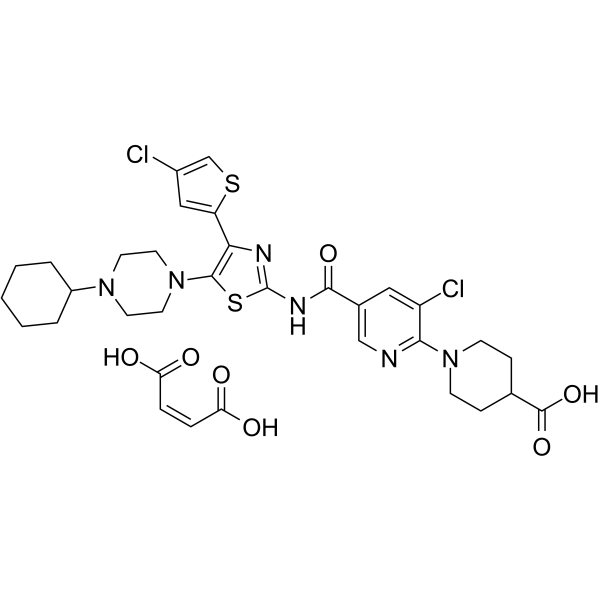
- HY-119647
-
|
|
COX
Cytochrome P450
|
Others
|
|
PPOH, a fatty acid derivative, is a selective cyclooxygenase (COX) inhibitor that inhibits arachidonic acid cyclooxygenase activity in renal cortical microsomes. In addition, PPOH acts on CYP4A2 and CYP4A3 with the IC50 values of 22 μM and 6.5 μM, respectively . PPOH is a click chemistry reagent, it contains an Alkyne group and can undergo copper-catalyzed azide-alkyne cycloaddition (CuAAc) with molecules containing Azide groups.
|
-
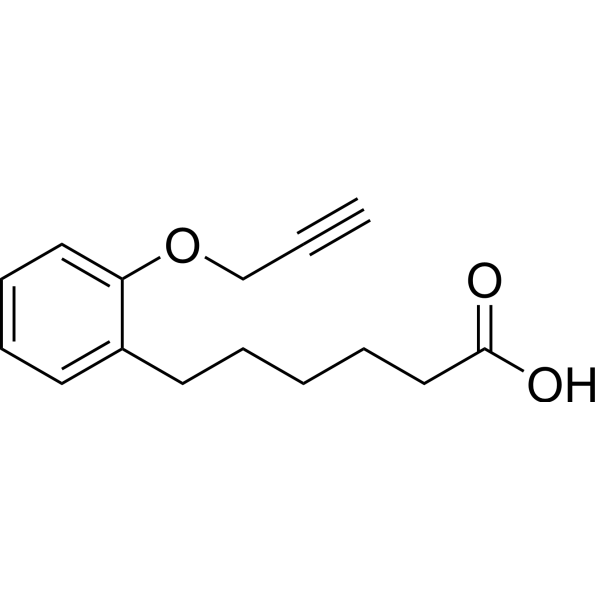
- HY-155666
-
|
|
Androgen Receptor
|
Cancer
|
|
YXG-158 (Compound 23-h) is an orally active AR degrader and CYP17A1 inhibitor. YXG-158 has AR degradation activity with DC50 value of 1.28 μM. YXG-158 can inhibit CYP17A1 with IC50 value of 100 nM. XG-158 can be used for the research of enzalutamide-resistant prostate cancer .
|
-
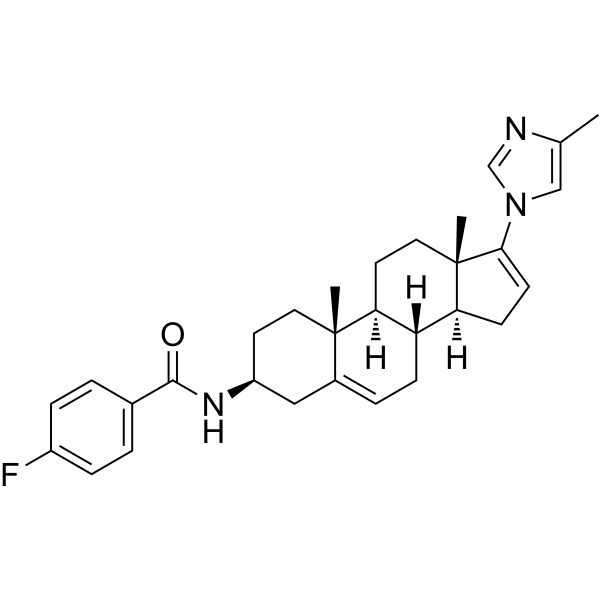
- HY-N0494
-
|
Gentiopicrin
|
Cytochrome P450
HCV
|
Inflammation/Immunology
|
|
Gentiopicroside, a naturally occurring iridoid glycoside, inhibits P450 activity, with an IC50 and a Ki of 61 µM and 22.8 µM for CYP2A6; Gentiopicroside has anti-inflammatoryand antioxidative effects.
|
-
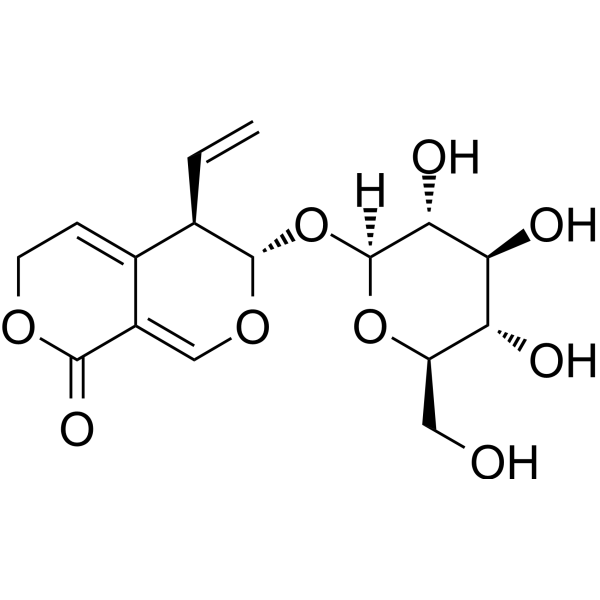
- HY-N9434
-
|
|
Cytochrome P450
|
Metabolic Disease
|
|
5,7,2',6'-Tetrahydroxyflavone is a natural flavonoid that inhibits hepatic testosterone 6β-hydroxylation (CYP3A4) activity with an IC50 of 7.8 μM .
|
-

- HY-10882R
-
|
|
Fungal
Bacterial
Autophagy
Antibiotic
|
Infection
Cancer
|
|
Clotrimazole (Standard) is the analytical standard of Clotrimazole. This product is intended for research and analytical applications. Clotrimazole is an imidazole derivative, an antifungal compound and is a CYP (cytochrome P450) inhibitor. Clotrimazole has antibacterial activity.
|
-
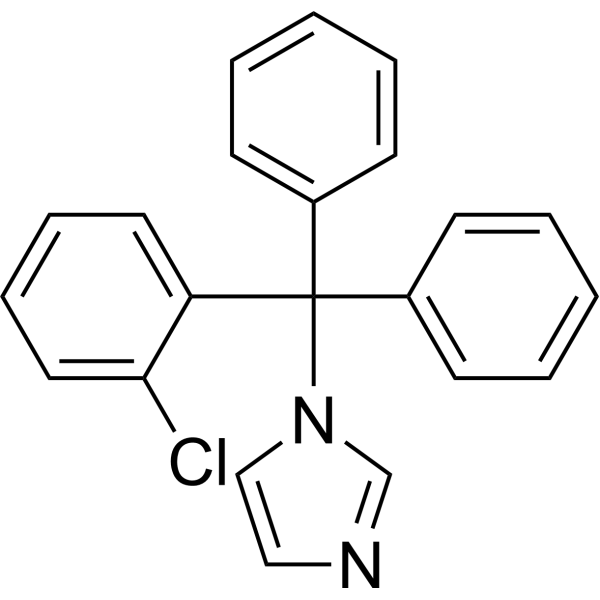
- HY-10882S1
-
-
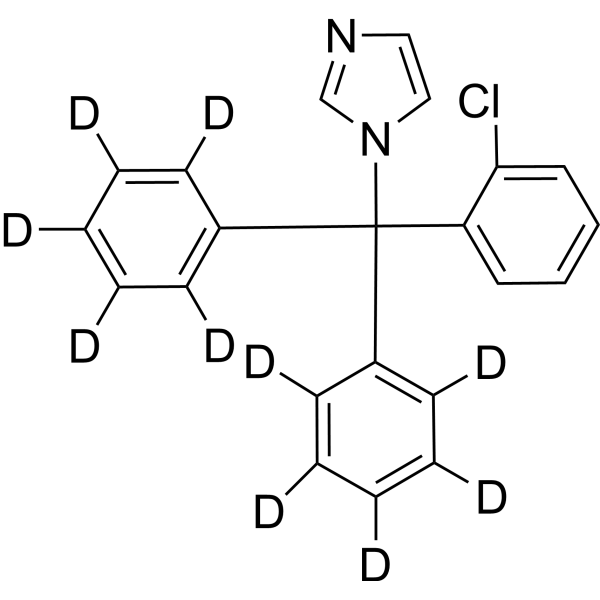
- HY-N7454
-
|
|
Antibiotic
Bacterial
|
Infection
|
|
Anhydroerythromycin A is a degradation product of the macrolide antibiotic erythromycin. Anhydroerythromycin A is formed via degradation of erythromycin in acidic aqueous solutions in vitro as well as in vivo. Anhydroerythromycin A is active against S. aureus and B. cereus in vitro (MICs = 12.5 and 6.25 μg/ml, respectively). Anhydroerythromycin A also inhibits steroid 6β-hydroxylase activity associated with the cytochrome P450 (CYP) isoform CYP3A in human liver microsomes.
|
-
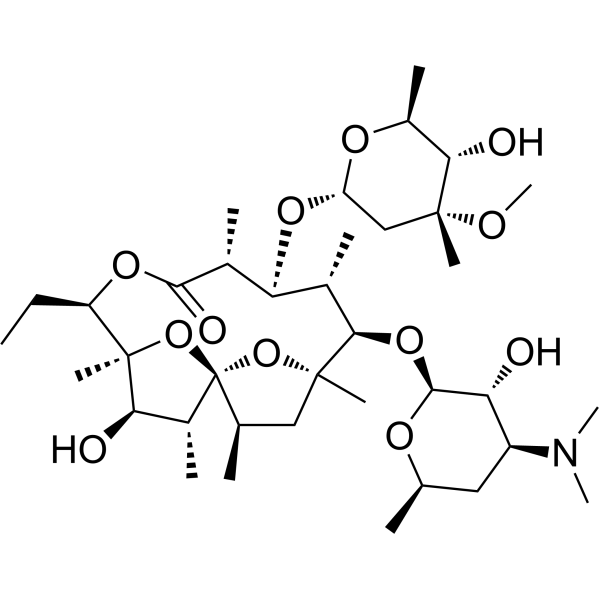
- HY-N11706
-
|
(+)-β-Cedrene
|
Fungal
|
Infection
Inflammation/Immunology
|
|
β-Cedrene ((+)-β-Cedrene) is a sesquiterpene compound that can be isolated from Centaurea kotschyi var. kotschyi and Centaurea kotschyi var. decumbens, exhibiting antibacterial, anti-inflammatory, antispasmodic, tonic, diuretic, sedative, insecticidal, and antifungal activities. β-Cedrene is also a potent competitive inhibitor of the CYP2B6-mediatedbupropion hydroxylase, with a Ki value of 1.6 μM .
|
-
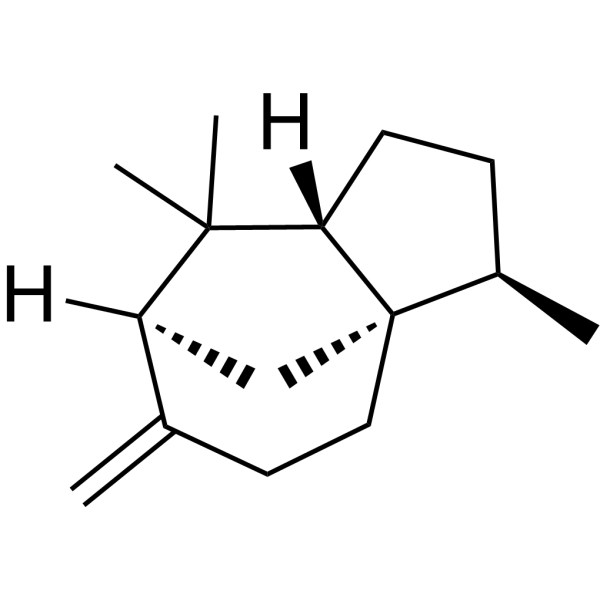
- HY-105124A
-
|
Ro 3-4787 hydrochloride
|
Adrenergic Receptor
|
Cardiovascular Disease
Endocrinology
|
|
Bufuralol (Ro 3-4787) hydrochloride is a potent non-selective, orally active β-adrenoreceptor antagonist with partial agonist activity. Bufuralol hydrochloride is a CYP2D6 probe substrate .
|
-
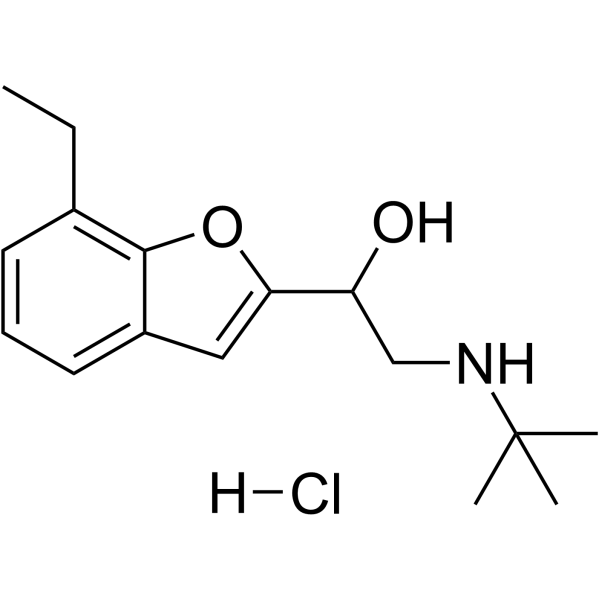
- HY-113327
-
|
|
Endogenous Metabolite
|
Cancer
|
|
1,3,7-Trimethyluric acid is the metabolite of caffeine. The metabolic ratio 1,3,7-Trimethyluric acid to caffeine can be evaluated as a biomarker to describe variability in CYP3A activity in a cohort .
|
-
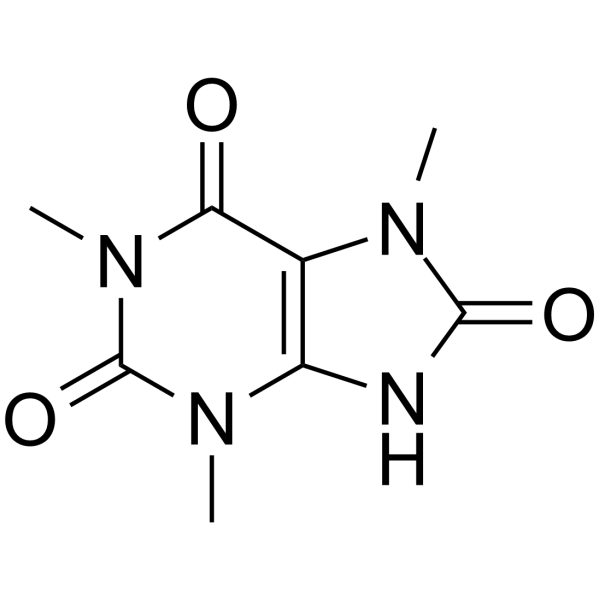
- HY-N0382S
-
-
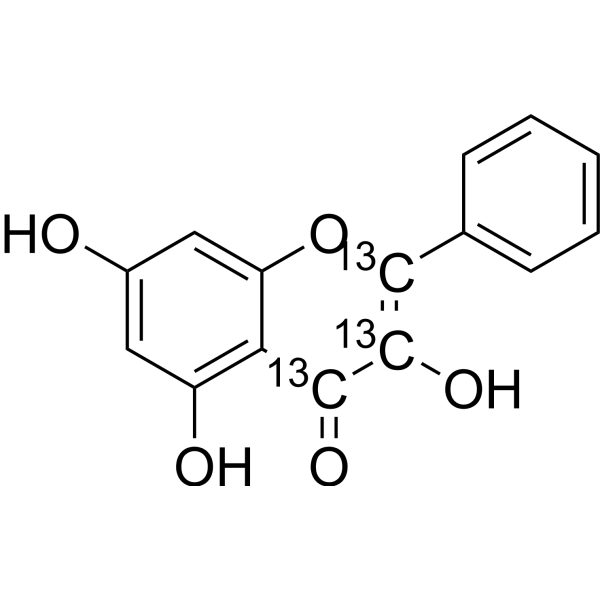
- HY-W087008
-
|
|
Cytochrome P450
|
Endocrinology
Cancer
|
|
7-Hydroxyflavanone is a potent inhibitor of aromatase (CYP19) activity with the IC50 of 65 μM. 7-Hydroxyflavanone exerts various biological effects, including anticarcinogenic, antioxidant and (anti-)estrogenic effects, and modula
|
-
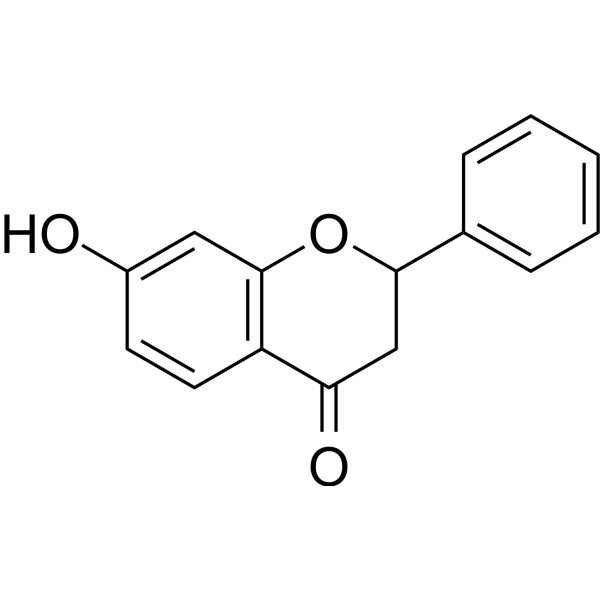
- HY-134217
-
|
|
Aryl Hydrocarbon Receptor
|
Cancer
|
|
KYN-101 is a potent, selective and orally active AHR inhibitor. KYN-101 decreases the CYP1A1 mRNA expression. KYN-101 shows anti-cancer activity .
|
-
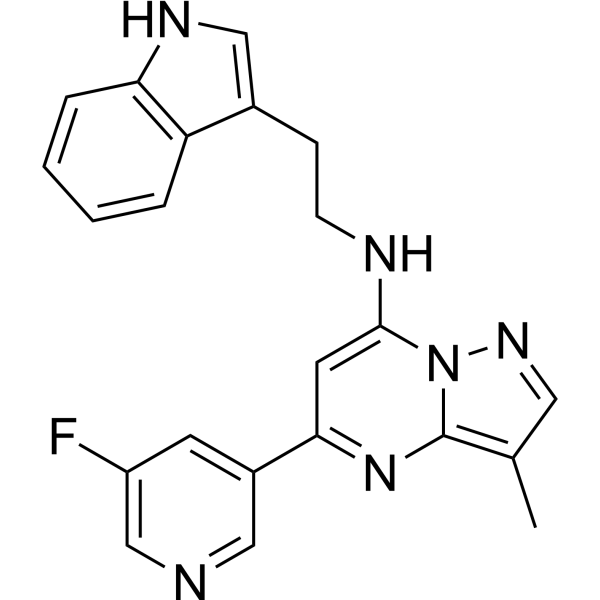
- HY-N0125R
-
|
|
Cytochrome P450
|
Cancer
|
|
Diosmetin (Standard) is the analytical standard of Diosmetin. This product is intended for research and analytical applications. Diosmetin is a natural flavonoid which inhibits human CYP1A enzyme activity with an IC50 of 40 μM in HepG2 cell.
|
-
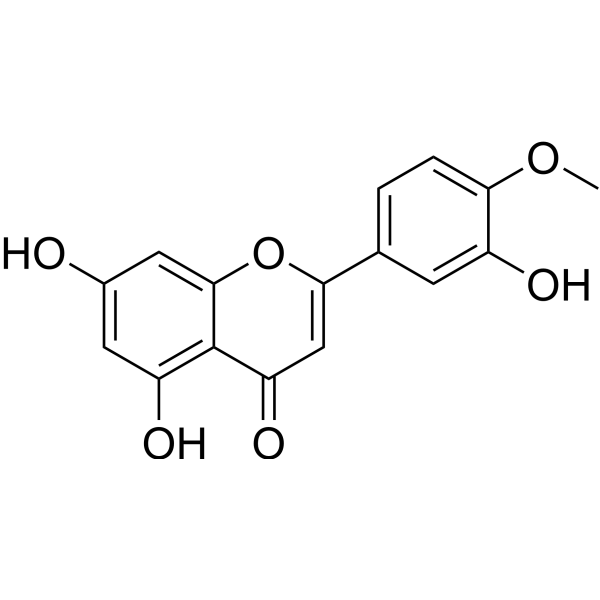
- HY-17508S1
-
|
|
Isotope-Labeled Compounds
|
Others
|
|
Clarithromycin-d3is the deuterium labeledClarithromycin(HY-17508) . Clarithromycin has a broad spectrum of antimicrobial activity. Clarithromycin inhibits the CYP3A4-catalyzed triazolam alpha-hydroxylation with the IC50 (Ki) value of 56 (43) μM . Clarithromycin significantly inhibits the HERG potassium current .Clarithromycin affects the autophagic flux by impairing the signaling pathway linking hERG1 and PI3K .
|
-

- HY-17508R
-
|
|
Bacterial
Cytochrome P450
Autophagy
Antibiotic
|
Infection
Cancer
|
|
Clarithromycin (Standard) is the analytical standard of Clarithromycin. This product is intended for research and analytical applications. Clarithromycin has a broad spectrum of antimicrobial activity. Clarithromycin inhibits the CYP3A4-catalyzed triazolam alpha-hydroxylation with the IC50 (Ki) value of 56 (43) μM . Clarithromycin significantly inhibits the HERG potassium current .Clarithromycin affects the autophagic flux by impairing the signaling pathway linking hERG1 and PI3K .
|
-

- HY-75054S
-
|
CB7630-d4
|
Isotope-Labeled Compounds
Cytochrome P450
|
Cancer
|
|
Abiraterone acetate-d4 is the deuterium labeled Abiraterone acetate. Abiraterone acetate (CB7630) is an oral, potent, selective, and irreversible inhibitor of CYP17A1 with antiandrogen activity. Abiraterone acetate is a proagent form of Abiraterone (CB7598).
|
-

- HY-105124
-
-

- HY-N0382R
-
|
Norizalpinin (Standard); 3,5,7-Trihydroxyflavone (Standard)
|
Cytochrome P450
Autophagy
|
Cancer
|
|
Galangin (Standard) is the analytical standard of Galangin. This product is intended for research and analytical applications. Galangin (Norizalpinin) is?an?agonist/antagonist?of the?arylhydrocarbon?receptor. Galangin (Norizalpinin) also shows inhibition of CYP1A1 activity.
|
-
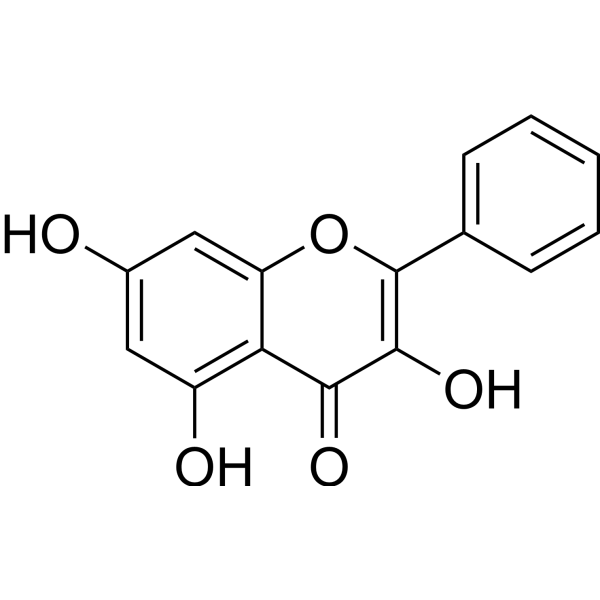
- HY-W271064
-
|
|
Fluorescent Dye
|
Others
|
|
1-Methylpyrene is a ubiquitous environmental pollutant and rodent carcinogen. Its mutagenic activity depends on sequential activation by various CYP and sulfotransferase (SULT) enzymes. 1-Methylpyrene induces chromosome loss and mitotic disturbance, proba
|
-
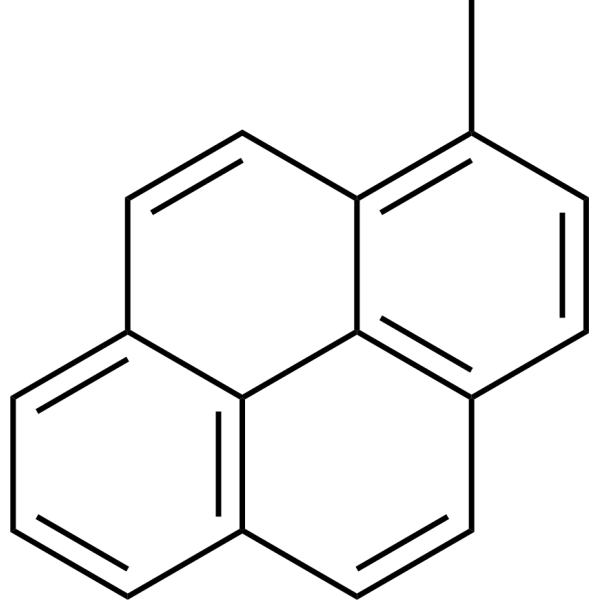
- HY-153618
-
|
|
Fungal
|
Infection
|
|
Antifungal agent 53 (A03) is a potent inhibitor of Candida albicans CYP51 with antifungal activity. Antifungal agent 53 prevents the formation of fungi biofilms. Antifungal agent 53 also exhibits good safety .
|
-
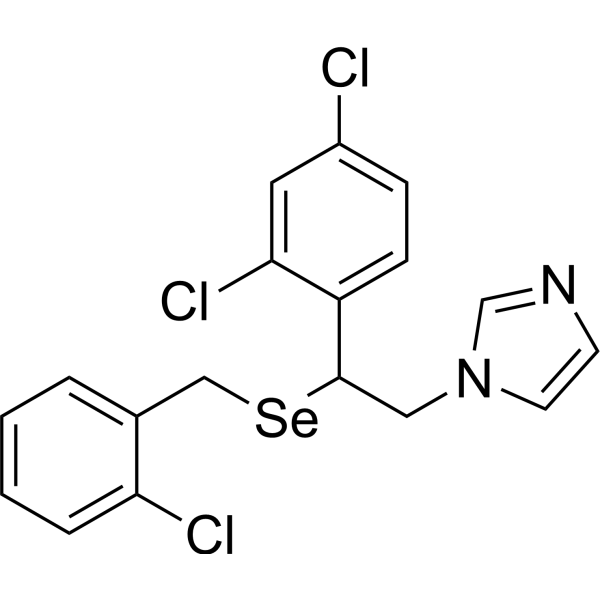
- HY-N0904R
-
|
Ginsenoside compound K(Standard); Ginsenoside K (Standard)
|
COX
NO Synthase
Cytochrome P450
|
Inflammation/Immunology
|
|
Ginsenoside C-K (Standard) is the analytical standard of Ginsenoside C-K. This product is intended for research and analytical applications. Ginsenoside C-K, a bacterial metabolite of G-Rb1, exhibits anti-inflammatory effects by reducing iNOS and COX-2. Ginsenoside C-K exhibits an inhibition against the activity of CYP2C9 and CYP2A6 in human liver microsomes with IC50s of 32.0±3.6 μM and 63.6±4.2 μM, respectively.
|
-
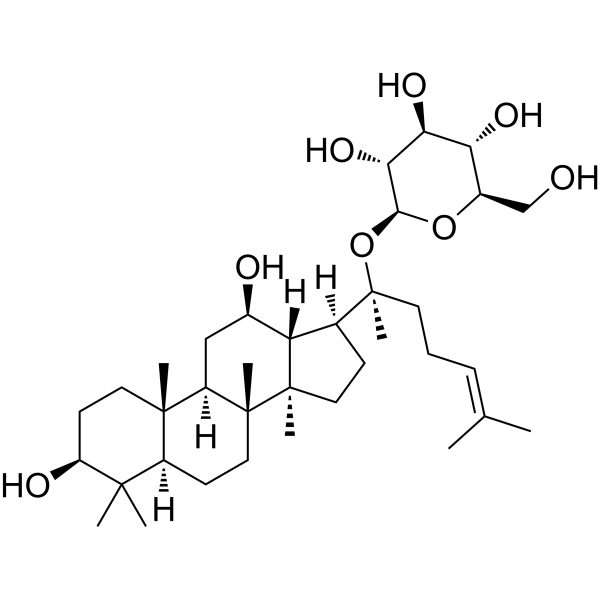
- HY-14273
-
|
BAL-4815; RO-0094815
|
Fungal
Cytochrome P450
Antibiotic
|
Infection
|
|
Isavuconazole (BAL-4815) is a triazole proagent with antifungal activity against yeasts, molds, and dimorphic fungi. Isavuconazole inhibits ergosterol biosynthesis and results in the disruption of fungal membrane structure and function. Isavuconazole is a moderate inhibitor of CYP3A4.
|
-
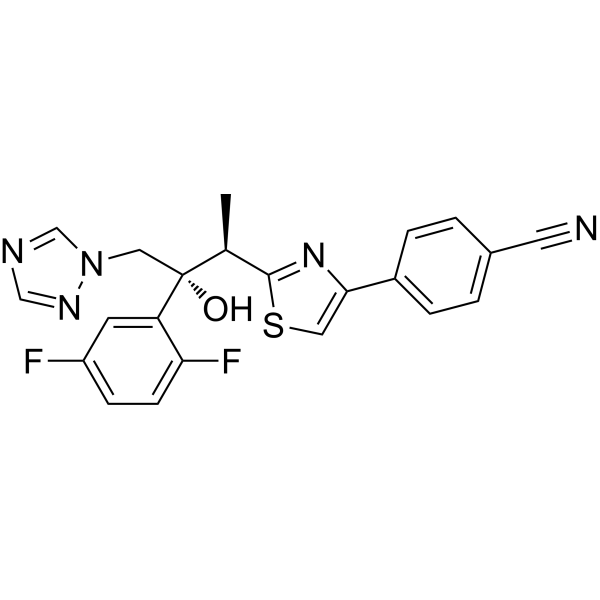
- HY-100064
-
|
|
|
|
|
O-Desmethyl gefitinib is an active metabolite of Gefitinib in human plasma. The formation of O-desmethyl gefitinib is dependent on CYP2D6 activity. O-desmethyl gefitinib inhibits EGFR with an IC50 of 36 nM in subcellular assays .
|
-
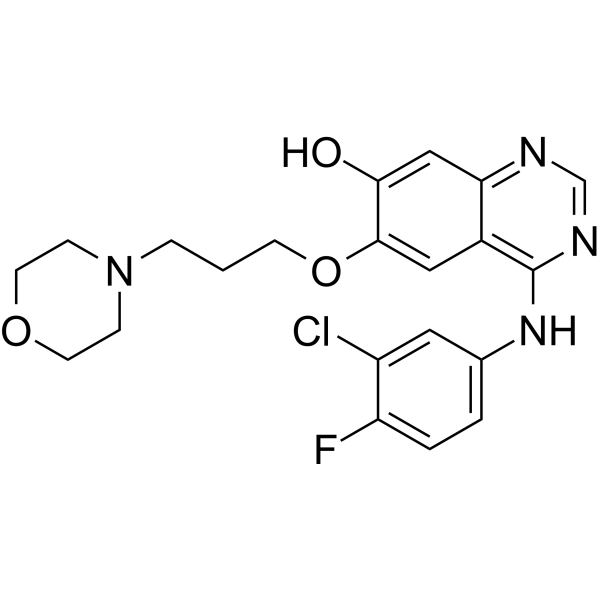
- HY-12433
-
-
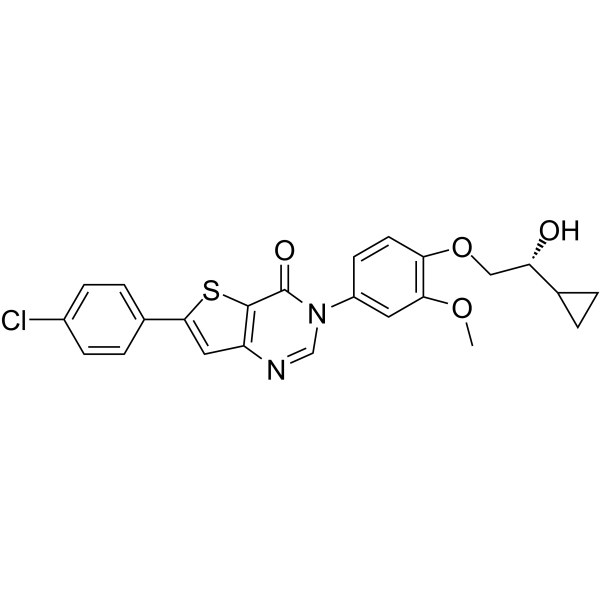
- HY-75054R
-
|
CB7630 (Standard)
|
Cytochrome P450
|
Cancer
|
|
Abiraterone acetate (Standard) is the analytical standard of Abiraterone acetate. This product is intended for research and analytical applications. Abiraterone acetate (CB7630) is an oral, potent, selective, and irreversible inhibitor of CYP17A1 with antiandrogen activity. Abiraterone acetate is a proagent form of Abiraterone (CB7598).
|
-
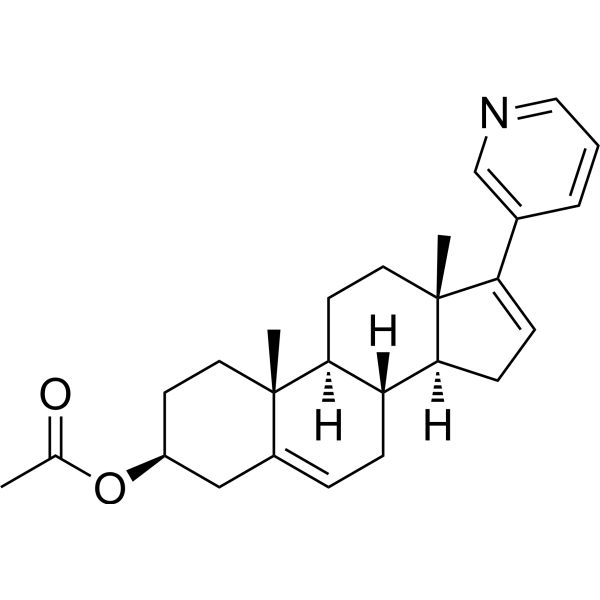
- HY-15996A
-
|
VT-464 (R enantiomer)
|
Cytochrome P450
|
Cancer
|
|
Seviteronel R enantiomer (VT-464 R enantiomer) is the R enantiomer of Seviteronel (VT-464), which is a potent CYP17 lyase inhibitor(h-Lyase IC50=69 nM); Seviteronel (VT-464) R enantiomer's activity is unknown.
|
-
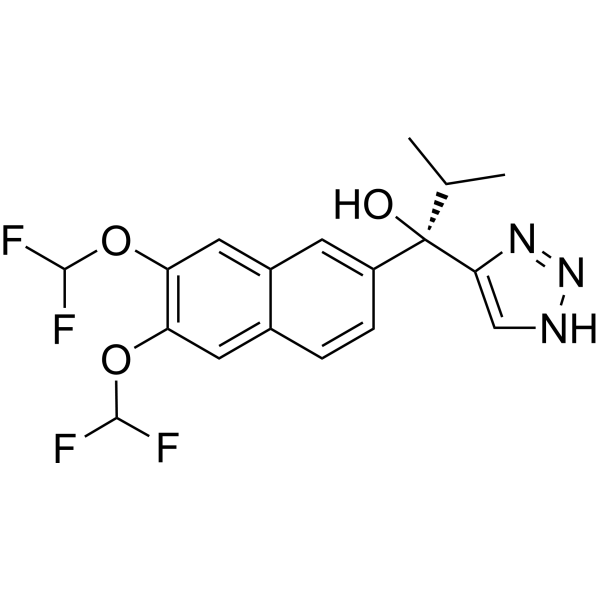
- HY-N10344
-
|
|
Others
|
Cancer
|
|
Glucoarabin is a bioactive glucosinolate. In Hepa1c1c7 cells, hydrolyzed Glucoarabin (hGSL 9) upregulates the phase II detoxification enzyme quinone reductase (NQO1), with no effect on cytochrome P450 (CYP) 1A1 activity .
|
-
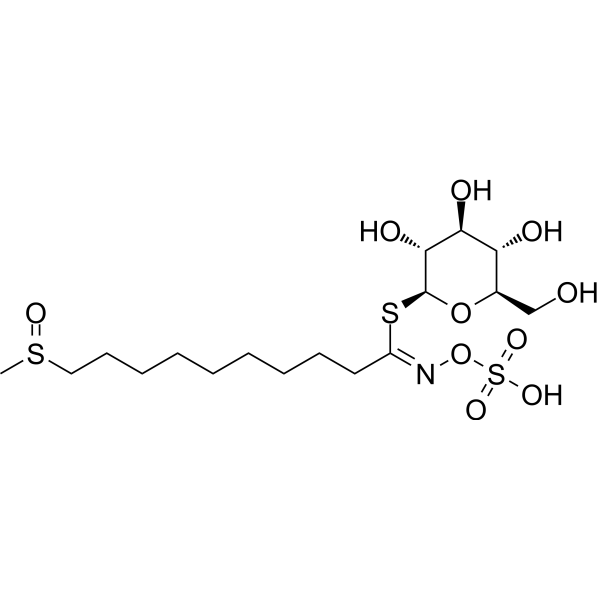
- HY-N9203
-
|
|
Bacterial
|
Infection
|
|
Pinobanksin 5-methyl ether can be isolated from Georgian Propolises. Pinobanksin 5-methyl ether has anti-helicobacter activity. Pinobanksin 5-methyl ether is effective inducer of CYP9Q enzyme .
|
-
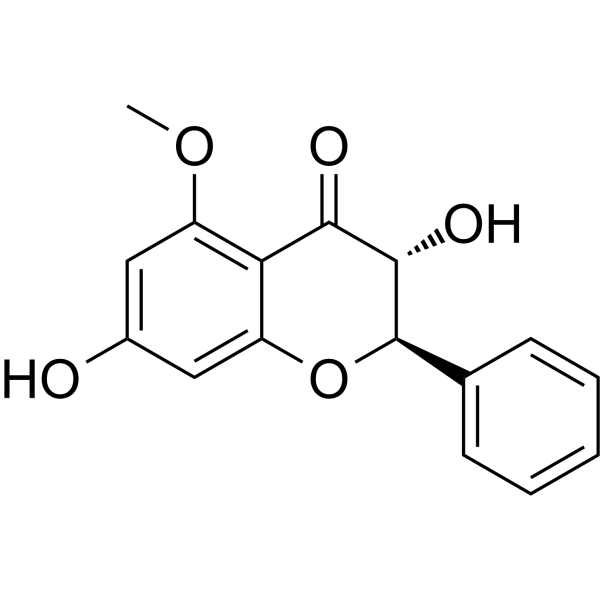
- HY-122277S
-
-
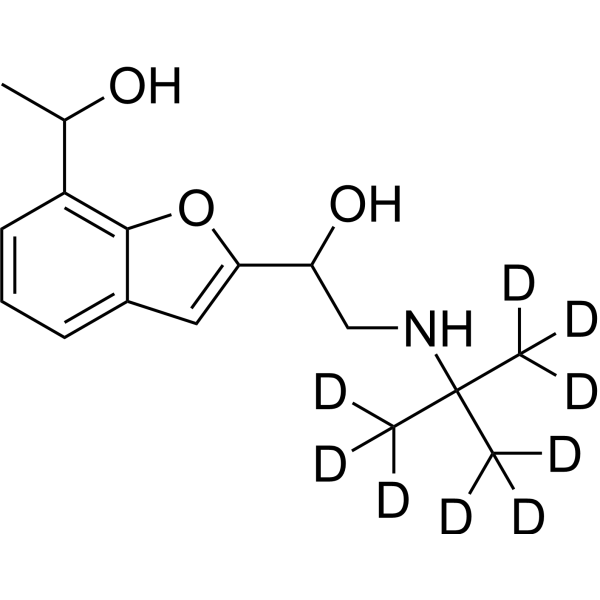
- HY-149977
-
|
|
Cytochrome P450
|
Cancer
|
|
Anticancer agent 111 (compound 11) is a potent cytochrome P450 inhibitor with an IC50 value of 3 μM for CYP3A4. Anticancer agent 111 has anticancer activity. Anticancer agent 111 can be used in research of cancer .
|
-
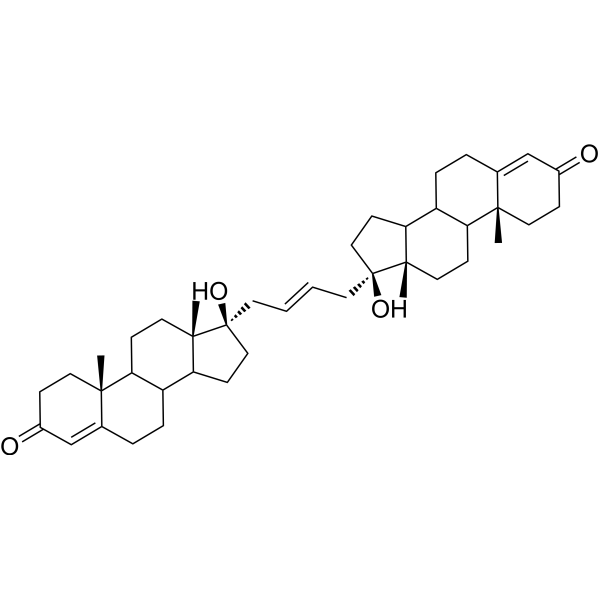
- HY-N0692
-
|
Gomisin-A; TJN-101; Wuweizi alcohol-B
|
Reactive Oxygen Species
Cytochrome P450
Autophagy
|
Cancer
|
|
Schisandrol B (Gomisin-A) is a major active constituent of Schisandra chinensis with hepato-protective effects. Schisandrol B inhibits reactive oxygen species (ROS) production. Schisandrol B inhibits the activity of P-glycoprotein and CYP3A and also has anti-inflammatory, anti-diabetic and antioxidant activities .
|
-
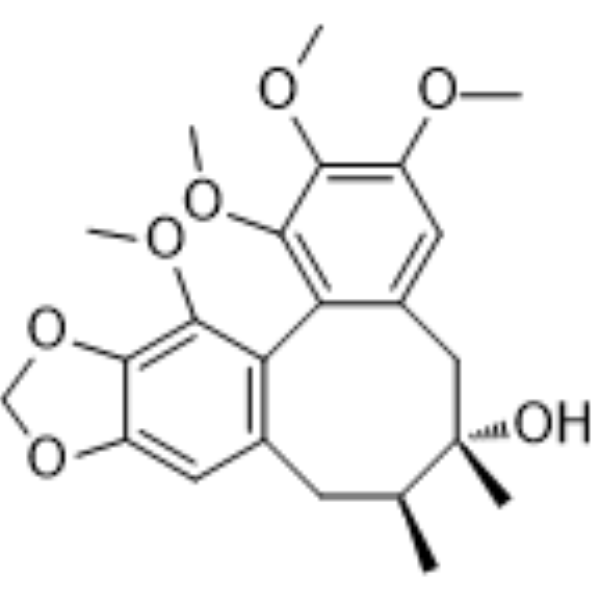
- HY-W008226
-
|
2,4,6-trihydroxyacetophenone; 1-(2,4,6-Trihydroxyphenyl)ethanone; THAP Monohydrate
|
Cytochrome P450
Bacterial
Antibiotic
|
Infection
Metabolic Disease
|
|
Phloracetophenone (2,4,6-trihydroxyacetophenone) is the aglycone part of acetophenone glycoside obtained from Curcuma comosa Roxb, with cholesterol-lowering activity. Phloracetophenone enhances cholesterol 7α-hydroxylase (CYP7A1) activity . Phloracetophenone stimulats bile secretion mediated through Mrp2 .
|
-

- HY-14751
-
|
SCH619734
|
Neurokinin Receptor
|
Neurological Disease
Cancer
|
|
Rolapitant (SCH619734) is a potent, selective, long-acting and orally active neurokinin 1 (NK1) receptor antagonist with a Ki of 0.66 nM. Rolapitant does not interact with CYP3A4. Rolapitant shows potent anti-emetic activity in a ferret emesis model .
|
-
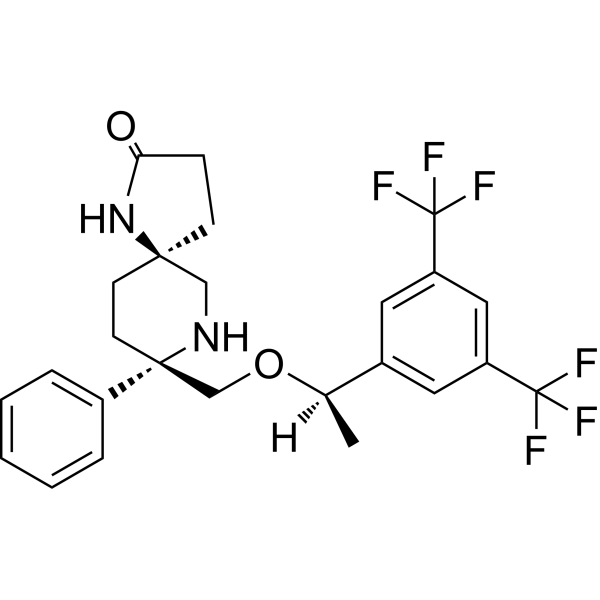
- HY-136063
-
|
|
Fungal
Cytochrome P450
|
Infection
|
|
Mefentrifluconazole is a novel azole derivative and used as an agrochemical broad-spectrum antifungal agent. Mefentrifluconazole is a potent, selective and orally active fungal CYP51 (Kd= 0.5 nM) inhibitor, but shows less inhibitory activity on human aromatase (IC50=0.92 μM) .
|
-

- HY-144285
-
|
|
CXCR
HIV
|
Inflammation/Immunology
|
|
CXCR4 antagonist 4 is a potent, orally active CXCR4 antagonist (IC50=24 nM) with diminished CYP 2D6 activity, improved PAMPA permeability, potent inhibition of human immunodeficiency virus entry (IC50=7 nM) .
|
-

- HY-14751A
-
|
SCH619734 hydrochloride
|
Neurokinin Receptor
|
Neurological Disease
|
|
Rolapitant (SCH619734) hydrochloride is a potent, selective, long-acting and orally active neurokinin 1 (NK1) receptor antagonist with a Ki of 0.66 nM. Rolapitant hydrochloride does not interact with CYP3A4. Rolapitant hydrochloride shows potent anti-emetic activity in a ferret emesis model .
|
-

- HY-16436
-
|
SCH619734 hydrochloride hydrate
|
Neurokinin Receptor
|
Neurological Disease
Cancer
|
|
Rolapitant hydrochloride hydrate (SCH619734 hydrochloride hydrate) is a potent, selective, long-acting and orally active neurokinin 1 (NK1) receptor antagonist with a Ki of 0.66 nM. Rolapitant hydrochloride hydrate does not interact with CYP3A4. Rolapitant hydrochloride hydrate shows potent anti-emetic activity in a ferret emesis model .
|
-
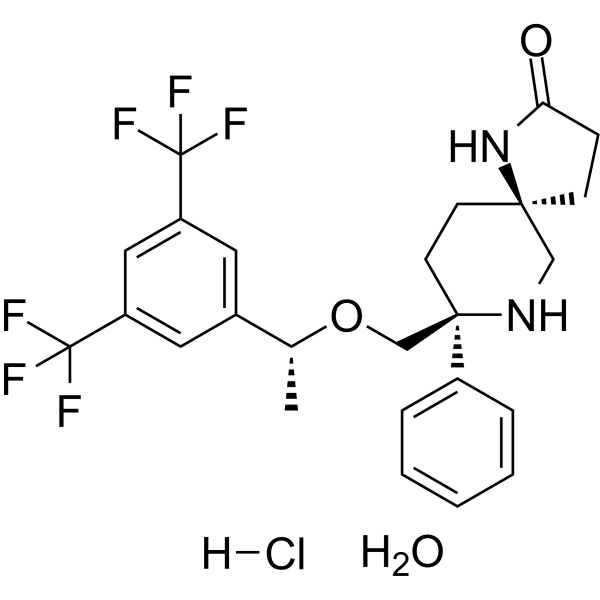
- HY-147919
-
|
|
Fungal
|
Infection
|
|
Antifungal agent 33 (compound 4e) is a potent antifungal agent. Antifungal agent 33 exhibits remarkable antifungal activity against C. albicans, with a MIC of 16 μg/mL. Antifungal agent 33 shows potent inhibitory activity against Lanosterol 14α-demethylase (CYP51), with an IC50 of 0.19 μg/mL .
|
-

- HY-12035
-
AMG-208
1 Publications Verification
|
c-Met/HGFR
Cytochrome P450
|
Cancer
|
|
AMG-208 is an orally active c-Met/RON dual selective inhibitor with an IC50 of 9 nM for c-Met. AMG-208 is a CYP3A4 inhibitor with an IC50 of 32 μM. AMG-208 has anti-cancer activity .
|
-
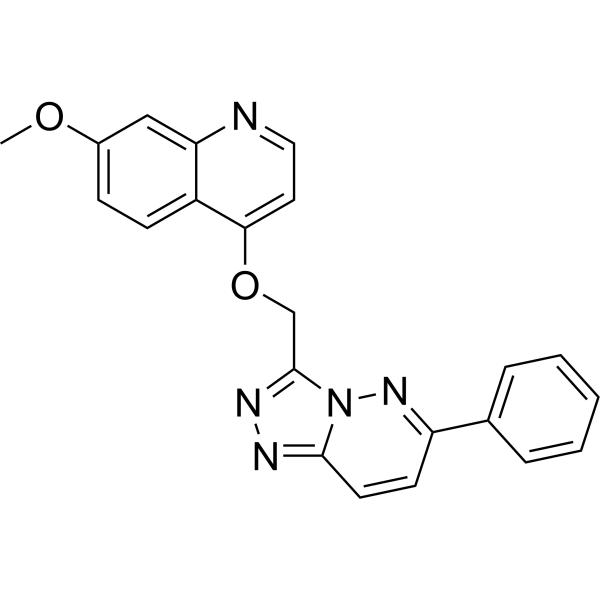
- HY-15996
-
|
VT-464
|
Cytochrome P450
Androgen Receptor
|
Cancer
|
|
Seviteronel (VT-464) is a potent CYP17 lyase inhibitor(h-Lyase IC50=69 nM) and an AR antagonist. Seviteronel demonstrates both exceptional in vitro lyase/hydroxylase selectivity (~10-fold) and oral activity in a hamster model of androgen biosynthesis inhibition.
|
-
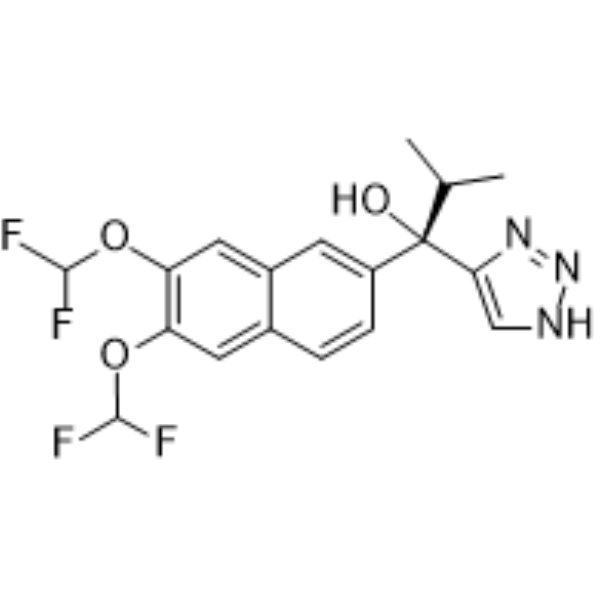
- HY-130606
-
|
|
NAMPT
Cytochrome P450
|
Cancer
|
|
Nampt-IN-5 is a potent nicotinamide phosphoribosyltransferase (NAMPT) inhibitor. Nampt-IN-5 also inhibits CYP3A4 activity and has cellular IC50s of 0.7 nM and 3.9 nM against A2780 and COR-L23, respectively .
|
-
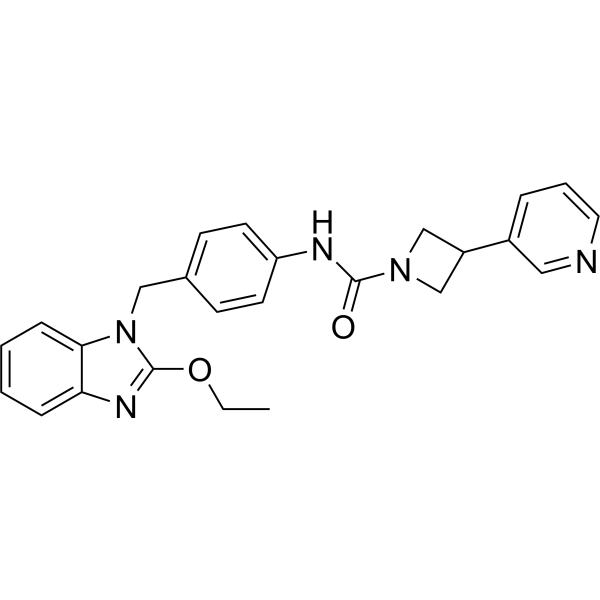
- HY-N6972
-
|
|
SARS-CoV
Cytochrome P450
Apoptosis
Parasite
|
Infection
Inflammation/Immunology
Cancer
|
|
Cepharanthine is a natural product that can be isolated from the plant Stephania cephalantha Hayata. Cepharanthine has anti-severe acute respiratory syndrome coronavirus 2 (anti-SARS-CoV-2) activities. Cepharanthine has good effective in suppressing viral proliferation (half maximal (50%) inhibitory concentration (IC50) and 90% inhibitory concentration (IC90) values of 1.90 and 4.46 µM . Cepharanthine can also effectively reverses P-gp-mediated multidrug resistance in K562 cells and increase enhances the sensitivity of anticancer agents in xenograft mice model . Cepharanthine shows inhibitory effects of human liver cytochrome P450 enzymes CYP3A4, CYP2E1 and CYP2C9. Cepharanthine has antitumor, anti-inflammatory and antinociceptive effects .
|
-

- HY-19435A
-
|
|
iGluR
Cytochrome P450
|
Neurological Disease
|
|
GYKI-47261 dihydrochloride is a competitive, orally active, and selective AMPA receptor antagonist with an IC50 of 2.5 μM. GYKI-47261 has broad spectrum anticonvulsive activity and neuroprotective effects. GYKI-47261 dihydrochloride is also a potent inducer of CYP2E1 .
|
-
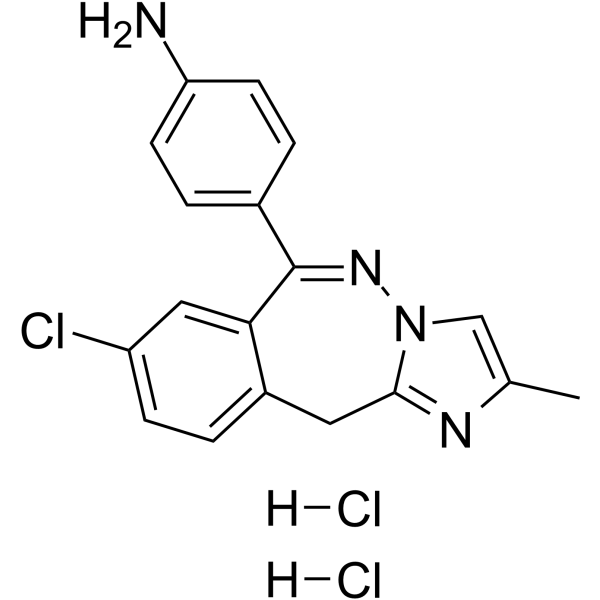
- HY-B0873
-
|
|
|
|
|
Uniconazole, a plant growth retardant, is a potent inhibitor of abscisic acid (ABA) catabolism with an IC50 of 68 nM against ABA 8’-hydroxylase. Uniconazole is a potent competitive inhibitor of CYP707A3 activity with a Ki of 8 nM. Uniconazole evidently inhibits gibberellin biosynthesis, and brassinosteroid biosynthesis is also inhibited to some extent .
|
-

- HY-N2689
-
|
(R)-6′,7′-DHB
|
Cytochrome P450
|
Cancer
|
|
(R)-6',7'-Dihydroxybergamottin ((R)-6′,7′-DHB) is a competitive inhibitor of human and rat CYP1A1 activity with Kis of 55 μM and 1.72 μM, respectively. (R)-6',7'-Dihydroxybergamottin has the potential for cancer research .
|
-

- HY-149813
-
|
|
P-glycoprotein
|
Cancer
|
|
P-gp inhibitor 14 (Compound 8a) is a high affinity P-gp inhibitor. P-gp inhibitor 14 reverses P-gp-mediated multidrug resistance (EC50=48.74 nM). P-gp inhibitor 14 has a weak inhibitory effect on CYP3A4 activity .
|
-
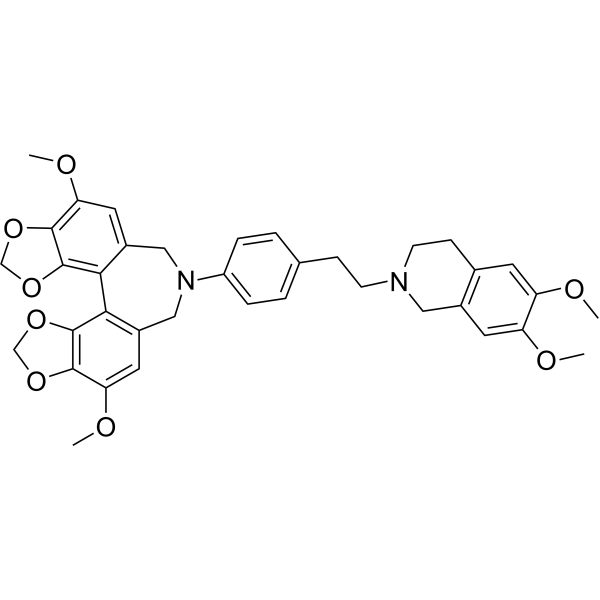
- HY-17614
-
|
SMT C1100; BMN 195; VOX-C1100
|
Cytochrome P450
|
Others
|
|
Ezutromid (SMT C1100) is a first-in-class, orally active benzoxazole utrophin modulator with an EC50 of 0.91 μM. Ezutromid can be used for the research Duchenne muscular dystrophy (DMD). Ezutromid inhibits CYP1A2 enzymic activity in human liver microsomes (HLM) with an IC50 of 5.4 μM .
|
-
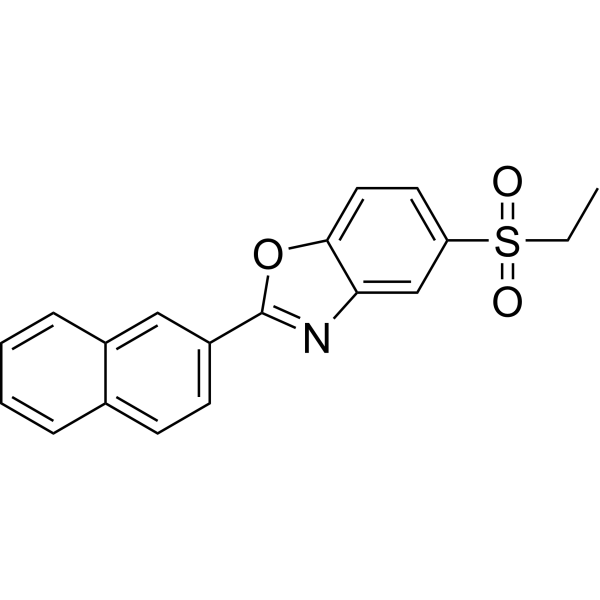
- HY-N3841
-
|
epsilon-Viniferin
|
Cytochrome P450
|
Neurological Disease
Metabolic Disease
Inflammation/Immunology
|
|
ε-Viniferin (epsilon-Viniferin), the dimer of Resveratrol and can be isolated from Vitis vinifera, displays a potent inhibitory for all the CYP activities, with Ki values from 0.5-20 μM. ε-Viniferin possesses potent antioxidant, anti-inflammatory, anti-diabetic, and anti-neurodegenerative capacity .
|
-
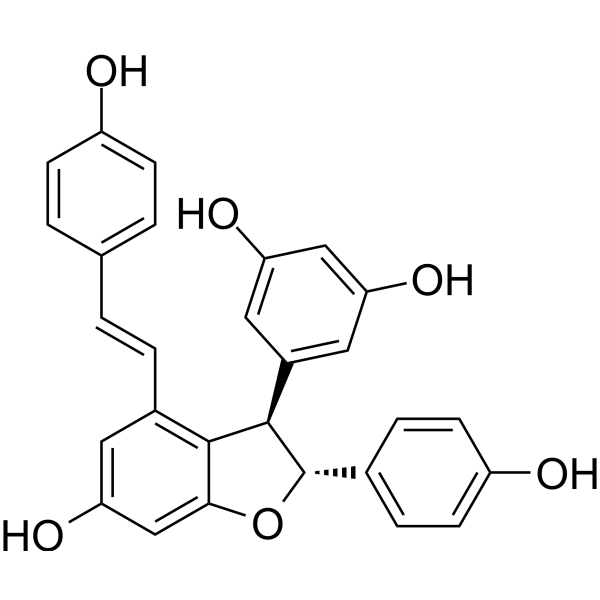
- HY-100064S
-
|
|
EGFR
|
Cancer
|
|
O-Desmethyl gefitinib-d8 is a deuterium labeled O-Desmethyl gefitinib. O-Desmethyl gefitinib is an active metabolite of Gefitinib in human plasma. The formation of O-desmethyl gefitinib is dependent on CYP2D6 activity. O-desmethyl gefitinib inhibits EGFR with an IC50 of 36 nM in subcellular assays[1][2].
|
-
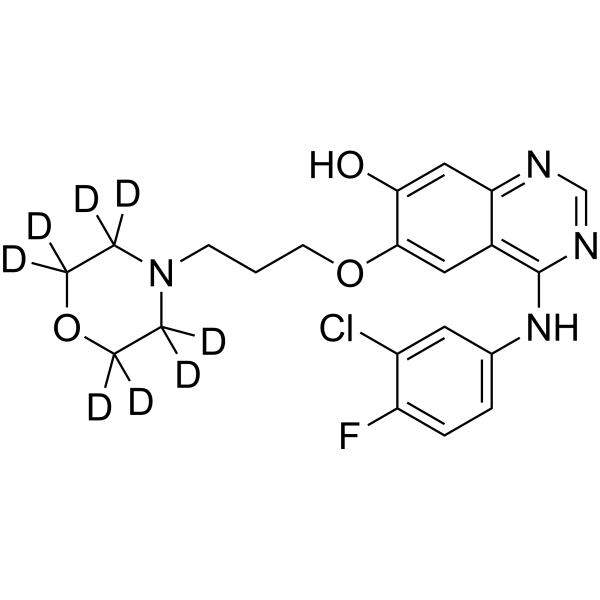
- HY-135111
-
|
|
Drug Metabolite
|
Infection
Metabolic Disease
Cancer
|
|
4-Desmethoxy Omeprazole is the active metabolite of Omeprazole. Omeprazole, a proton pump inhibitor (PPI), is available for treatment of acid-related gastrointestinal disorders. Omeprazole shows competitive inhibition of CYP2C19 activity with a Ki of 2 to 6 μM . Omeprazole also inhibits growth of Gram-positive and Gram-negative bacteria .
|
-

- HY-100064S1
-
|
|
Isotope-Labeled Compounds
EGFR
|
Cancer
|
|
O-Desmethyl gefitinib-d6 is the deuterium labeled O-Desmethyl gefitinib. O-Desmethyl gefitinib is an active metabolite of Gefitinib in human plasma. The formation of O-desmethyl gefitinib is dependent on CYP2D6 activity. O-desmethyl gefitinib inhibits EGFR with an IC50 of 36 nM in subcellular assays[1][2].
|
-
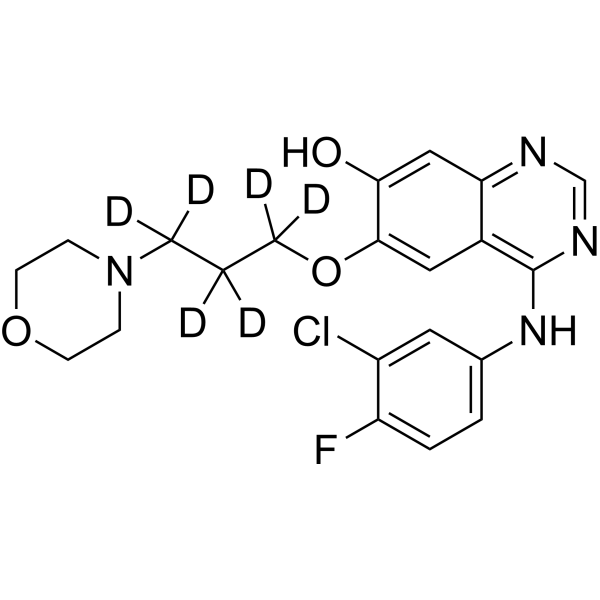
- HY-148070
-
|
|
FLT3
FAK
Cytochrome P450
|
Cancer
|
|
FLT3-IN-17 inhibits CYPs and FLT3 mutants activity (IC50s: <0.5 nM for D835Y). FLT3-IN-17 is also a FAK inhibitor, with an IC50 value of 12 nM. FLT3 ligand-2 can be used in the research of cancers .
|
-
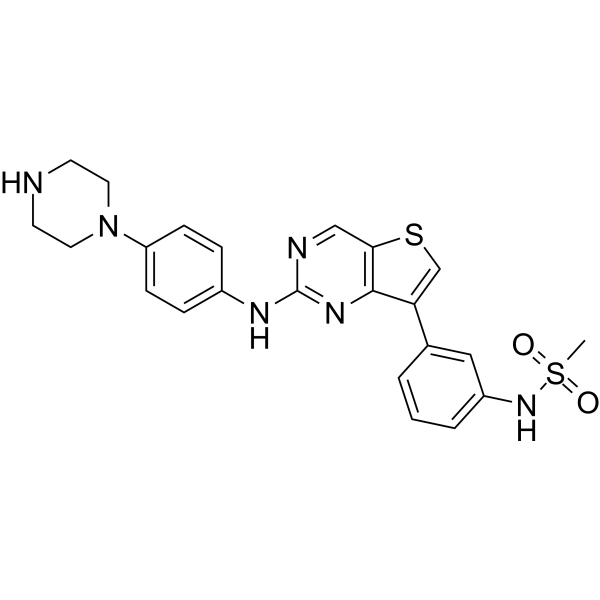
- HY-D0146
-
|
BzRes; 7-Benzyloxyresorufin; 7-Benzyloxyphenoxazone
|
Fluorescent Dye
|
Others
|
|
Resorufin benzyl ether (BzRes), a fluorogenic enzyme substrate, can be used to detect CYP3A4 enzyme activity. Resorufin benzyl ether modified with a recognizing moiety boronate, can be used for ONOO - detection via a self-immolation mechanism. Ex/Em=530-570 nm/590 nm .
|
-
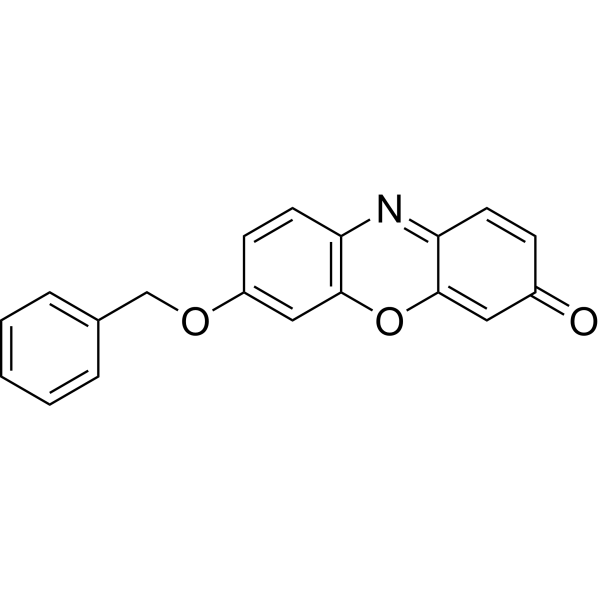
- HY-148822
-
|
|
NAMPT
|
Neurological Disease
|
|
Nampt activator-2 (compound 34) is a potent NAMPT activator, with EC50 of 0.023 μM. Nampt activator-2 shows moderate activity against CYP2C9 (0.060 μM), 2D6 (0.41 μM) and 2C19 (0.59 μM) .
|
-

- HY-117010
-
|
|
Cytochrome P450
HSV
SGLT
|
Infection
Metabolic Disease
|
|
Kushenol K, a flavonoid antioxidant isolated from the roots of Sophora flavescens. Kushenol K is a cytochrome P-450 3A4 (CYP3A4) inhibitor with a Ki value of 1.35 μM . Kushenol K shows weak antiviral activity against HSV-2 (EC50 of 147 μM) . Kushenol K also inhibits the activity of SGLT1 and SGLT2 .
|
-
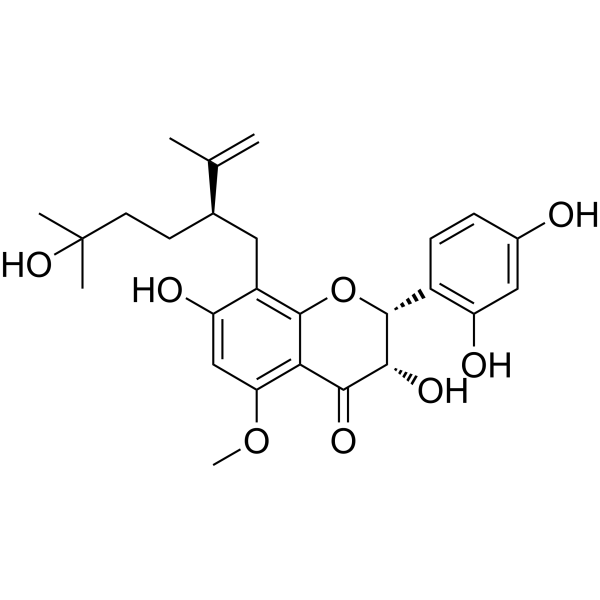
- HY-123319A
-
|
|
Bacterial
Antibiotic
|
Infection
|
|
Antofloxacin is a well tolerate, orally active and broad-spectrum 8-amino-fluoroquinolone with potent antibacterial activities. Antofloxacin shows superior antibacterial activity against gyrA mutation-positive H. pylori strains, especially in Asn87- mutated strains, compared to levofloxacin. Antofloxacin is a weak, reversible inhibitor of CYP1A2 for the research of infections caused by a diverse group of bacterial species .
|
-

- HY-123319
-
|
|
Bacterial
Antibiotic
|
Infection
|
|
Antofloxacin hydrochloride is a well tolerate, orally active and broad-spectrum 8-amino-fluoroquinolone with potent antibacterial activities. Antofloxacin hydrochloride shows superior antibacterial activity against gyrA mutation-positive H. pylori strains, especially in Asn87- mutated strains, compared to levofloxacin. Antofloxacin hydrochloride is a weak, reversible inhibitor of CYP1A2 for the research of infections caused by a diverse group of bacterial species .
|
-
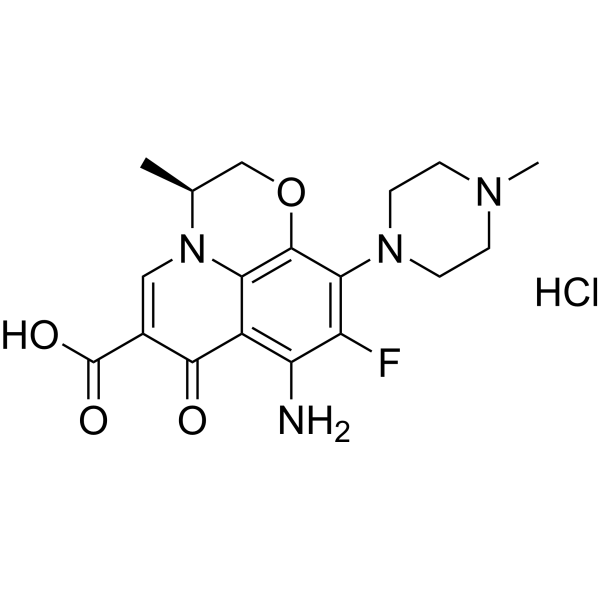
- HY-148592
-
|
|
Cytochrome P450
|
Cancer
|
|
Antitumor agent-87 is a potent antitumor agent. Antitumor agent-87 shows a high affinity for CYP1A1 with a Ki value of 0.23 µM. Antitumor agent-87 shows antiproliferative activity. Antitumor agent-87 induces cell cycle arrest at the G2/M phase. Antitumor agent-87 show antitumoral activity .
|
-
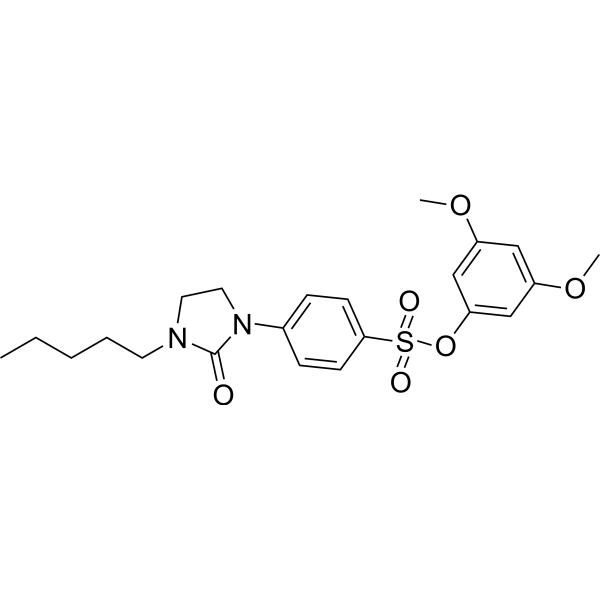
- HY-146464
-
|
|
Fungal
|
Infection
|
|
Antifungal agent 30 (compound A18) is a potent antifungal agent. Antifungal agent 30 shows excellent antifungal activity against Candida albicans (CPCC400616) and Aspergillus fumigatus, with MIC of 0.03 and 0.5 μg/mL, respectively. Antifungal agent 30 also shows excellent antifungal activity against fluconazole-resistant strains. The potent antifungal activity of Antifungal agent 30 mainly causes by hydrogen and coordination bond interaction with the CYP51 .
|
-
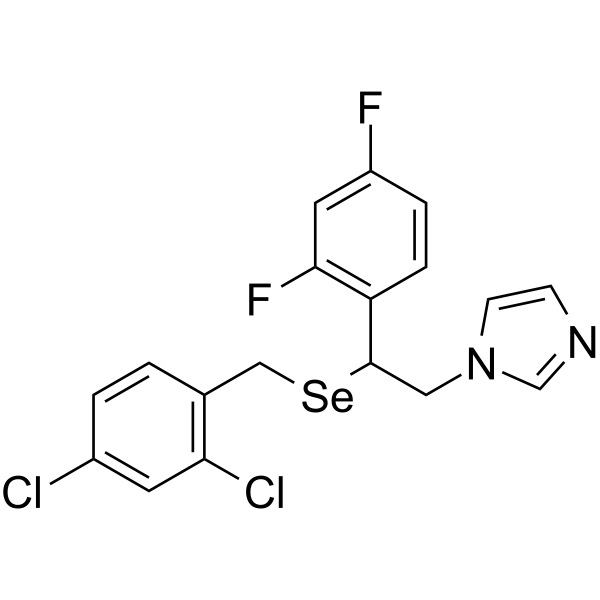
- HY-B0113S
-
|
H 16868-d3
|
Proton Pump
Bacterial
Autophagy
|
Infection
Metabolic Disease
Cancer
|
|
Omeprazole-d3 is deuterium labeled Omeprazole. Omeprazole, a proton pump inhibitor (PPI), is available for treatment of acid-related gastrointestinal disorders. Omeprazole shows competitive inhibition of CYP2C19 activity with a Ki of 2 to 6 μM[1]. Omeprazole also inhibits growth of Gram-positive and Gram-negative bacteria[2].
|
-

- HY-123777
-
|
|
Fungal
|
Infection
Inflammation/Immunology
|
|
VT-1598 is an orally active and selective fungal inhibitor targeting CYP51. VT-1598 shows anti-fungal activity against Candida auris . VT-1598 is a click chemistry reagent, it contains an Alkyne group and can undergo copper-catalyzed azide-alkyne cycloaddition (CuAAc) with molecules containing Azide groups.
|
-
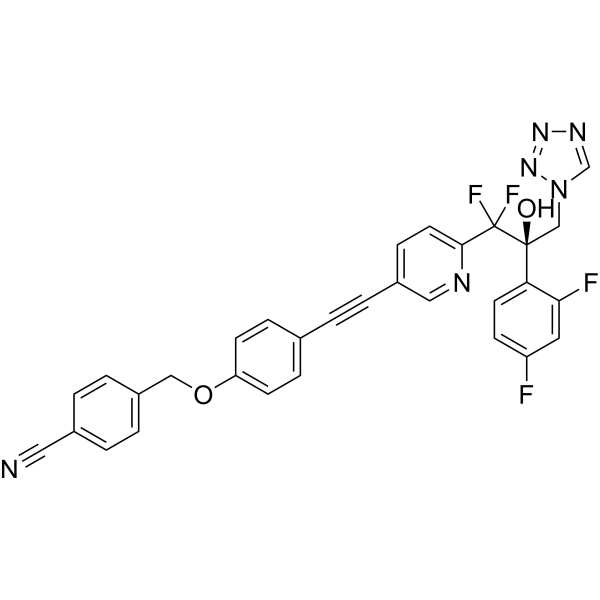
- HY-123777A
-
|
|
Cytochrome P450
|
Infection
|
|
VT-1598 tosylate is an orally active and selective fungal inhibitor targeting CYP51. VT-1598 tosylate shows anti-fungal activity against C. auris . VT-1598 (tosylate) is a click chemistry reagent, it contains an Alkyne group and can undergo copper-catalyzed azide-alkyne cycloaddition (CuAAc) with molecules containing Azide groups.
|
-

- HY-153989
-
|
|
Ras
Cytochrome P450
|
Cancer
|
|
SOS1-IN-16 (Comp 54) is a selective inhibitor of SOS1 with an IC50 of 7.2 nM. SOS1-IN-16 has inhibitory activity of CYP3A4 when using testosterone as a substrate, with an IC50 of 8.9μM. SOS1-IN-16 can be used for cancer research .
|
-

- HY-B1462S
-
|
|
Cytochrome P450
|
Inflammation/Immunology
|
|
Chlorzoxazone-d3 is the deuterium labeled Chlorzoxazone. Chlorzoxazone is a centrally acting muscle relaxant used to treat muscle spasm and the resulting pain or discomfort. It acts on the spinal cord by depressing reflexes.Chlorzoxazone is currently being used as a marker substrate in vitro/vivo studies to quantify cytochrome P450 2E1 (CYP2E1) activity in humans.
|
-

- HY-N1457
-
|
|
|
|
|
Chrysosplenetin is one of the polymethoxylated flavonoids in Artemisia annua L. (Compositae) and other several Chinese herbs. Chrysosplenetin inhibits P-gp activity and reverses the up-regulated P-gp and MDR1 levels induced by artemisinin (ART). Chrysosplenetin significantly augments the rat plasma level and anti-malarial efficacy of ART, partially due to the uncompetitive inhibition effect of Chrysosplenetin on rat CYP3A .
|
-

- HY-N3841A
-
|
|
Cytochrome P450
|
Metabolic Disease
|
|
δ-Viniferin is a resveratrol dehydrodimer, an isomer of ε-Viniferin (HY-N3841) . ε-Viniferin (epsilon-Viniferin), the dimer of Resveratrol, displays a potent inhibitory for all the CYP activities, with Ki values from 0.5-20 μM. ε-Viniferin possesses potent antioxidant, anti-inflammatory, anti-diabetic, and anti-neurodegenerative capacity.
|
-
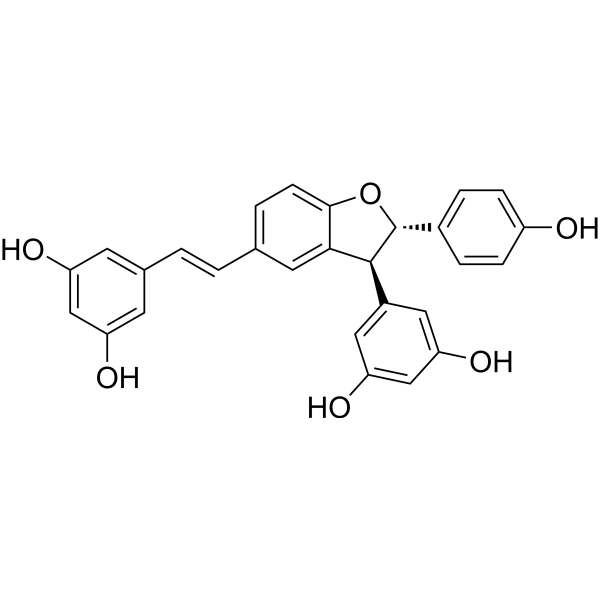
- HY-N0453R
-
-

- HY-13269
-
|
|
HIV
HIV Integrase
|
Infection
Inflammation/Immunology
|
|
BMS-707035 is a potent orally active HIV-1 integrase strand transfer inhibitor (INSTI). BMS-707035 has enzyme inhibitory with an IC50 value of 3 nM. BMS-707035 also has weak CYP inhibiton and antiviral activity. BMS-707035 can be used for the research of human immunodeficiency virus-1 (HIV-1) .
|
-
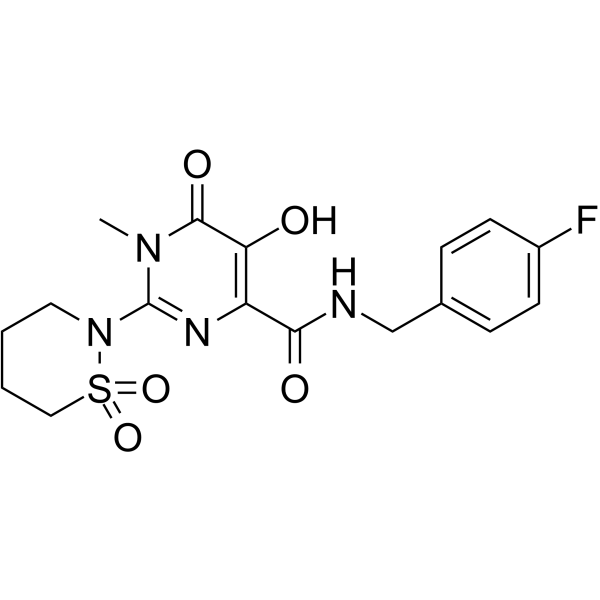
- HY-B0113
-
|
H 16868
|
Proton Pump
Autophagy
Bacterial
Phospholipase
|
Infection
Metabolic Disease
Cancer
|
|
Omeprazole (H 16868), a proton pump inhibitor (PPI), is available for treatment of acid-related gastrointestinal disorders. Omeprazole shows competitive inhibition of CYP2C19 activity with a Ki of 2 to 6 μM . Omeprazole also inhibits growth of Gram-positive and Gram-negative bacteria .Omeprazole is a potent brain penetrant neutral sphingomyelinase (N-SMase) inhibitor (exosome inhibitor) .
|
-

- HY-N2259
-
|
(+)-Curcumenol
|
|
|
|
Curcumenol ((+)-Curcumenol) is a potent CYP3A4 inhibitor with an IC50 of 12.6 μM, which is one of constituents in the plants of medicinally important genus of Curcuma zedoaria, with neuroprotection, anti-inflammatory, anti-tumor and hepatoprotective activities. Curcumenol ((+)-Curcumenol) suppresses Akt-mediated NF-κB activation and p38 MAPK signaling pathway in LPS-stimulated BV-2 microglial cells .
|
-
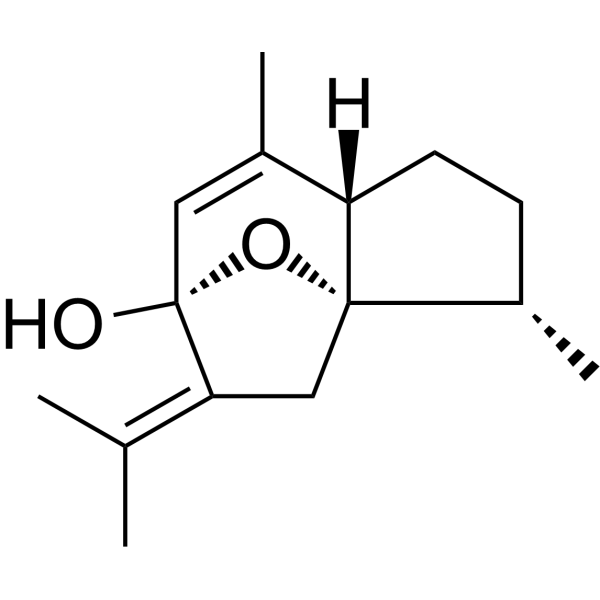
- HY-B0113A
-
|
H 16868 sodium
|
|
|
|
Omeprazole sodium (H 16868 sodium), a proton pump inhibitor (PPI), is available for treatment of acid-related gastrointestinal disorders. Omeprazole sodium shows competitive inhibition of CYP2C19 activity with a Ki of 2 to 6 μM . Omeprazole sodium also inhibits growth of Gram-positive and Gram-negative bacteria . Omeprazole is a potent brain penetrant neutral sphingomyelinase (N-SMase) inhibitor (exosome inhibitor) .
|
-

- HY-146458
-
|
|
Bacterial
Cytochrome P450
|
Infection
|
|
Antibacterial agent 102 (compound 32) possesses potent in vitro and in vivo antibacterial activity, with MICs < 0.5 μg/mL in Staphylococcus aureus (S. aureus). Antibacterial agent 102 also moderately inhibits CYP3A4 with an IC50 value of 6.148 μM. Antibacterial agent 102 can reduce Methicillin-resistant Staphylococcus aureus (MRSA) load in thigh infected mice .
|
-
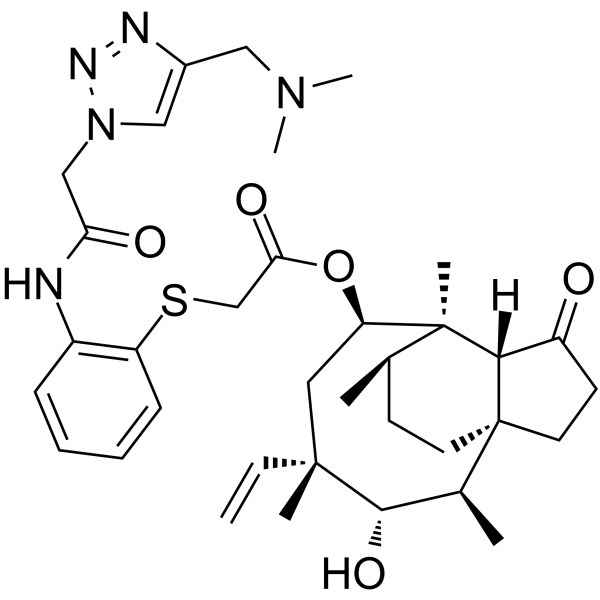
- HY-B1218
-
|
|
Cytochrome P450
Antibiotic
Bacterial
Necroptosis
Apoptosis
|
Infection
Cardiovascular Disease
|
|
Sulfaphenazole is a selective inhibitor of human cytochrome P450 (CYP) 2C9 enzyme. Sulfaphenazole is a cytoprotective agent against light-induced death of photoreceptors. Sulfaphenazole inhibits light-induced necrosis and mitochondrial stress-initiated apoptosis. Sulfaphenazole is an off patent sulfonamide antibiotic and demonstrates bactericidal activity through enhanced M1 macrophage activity. Sulfaphenazole can significantly reduce infarct size and restore post-ischemic coronary flow following ischemia and reperfusion .
|
-
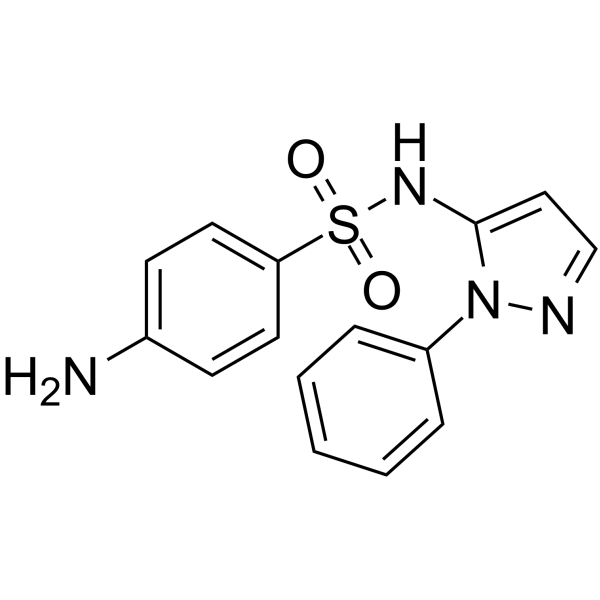
- HY-132866
-
|
|
P-glycoprotein
|
Cancer
|
|
YS-370 (compound 44) is a potent, high selective, and orally active inhibitor of P-glycoprotein (P-gp). YS-370 stimulates the P-gp ATPase activity and has moderate inhibition against CYP3A4. YS-370 effectively reverses multidrug resistance (MDR) to paclitaxel and colchicine in SW620/AD300 and HEK293T-ABCB1 cells. YS-370 in combination with paclitaxel achieves much stronger antitumor activity .
|
-
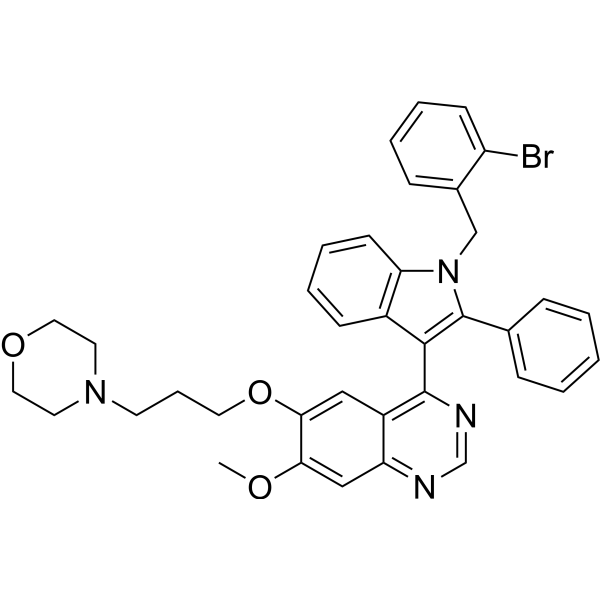
- HY-155992
-
|
|
Sigma Receptor
|
Neurological Disease
|
|
WLB-89462 (Compound 20c) is a selective σ2 receptor ligand (Ki: 13 nM). WLB-89462 has neuroprotective activity. WLB-89462 improves short-term memory impairment induced by Aβ peptide in rats. WLB-89462 has good ADMET profile (good solubility, no CYP inhibition, good metabolic stability, high permeability, brain penetration, and high oral exposure in rodents) .
|
-

- HY-B0113S1
-
|
H 16868-d3-1
|
Proton Pump
Autophagy
Bacterial
Phospholipase
|
Infection
Metabolic Disease
Cancer
|
|
Omeprazole-d3-1 is the deuterium labeled Omeprazole. Omeprazole (H 16868), a proton pump inhibitor (PPI), is available for treatment of acid-related gastrointestinal disorders. Omeprazole shows competitive inhibition of CYP2C19 activity with a Ki of 2 to 6 μM[1]. Omeprazole also inhibits growth of Gram-positive and Gram-negative bacteria[2].Omeprazole is a potent brain penetrant neutral sphingomyelinase (N-SMase) inhibitor (exosome inhibitor)[3].
|
-
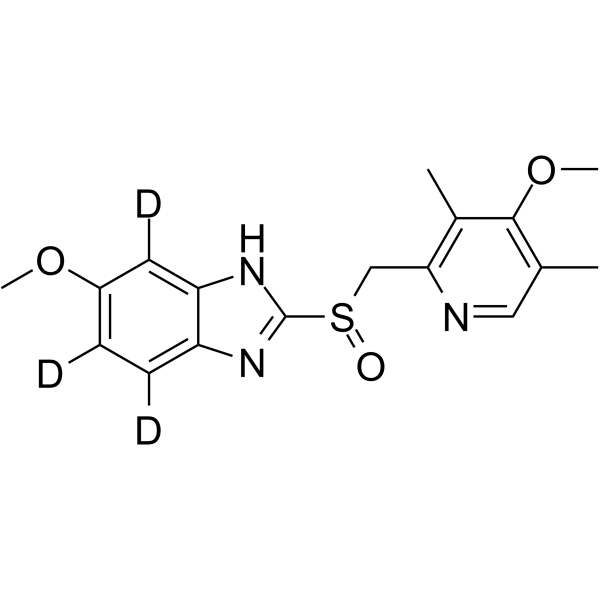
- HY-147999
-
|
|
Bacterial
Fungal
Cytochrome P450
|
Infection
|
|
GlcN-6-P Synthase-IN-1 (Compound 4d) is a Glucosamine-6-phosphate (GlcN-6-P) synthase inhibitor with an IC50 of 3.47 μM. GlcN-6-P Synthase-IN-1 exhibits significant antimicrobial activity. GlcN-6-P Synthase-IN-1 has good penetration in the CNS and is able to inhibit the cytochrome P450, CYP3A4 isoform .
|
-

- HY-N6948S
-
|
|
Others
Isotope-Labeled Compounds
|
Inflammation/Immunology
|
|
Linalyl acetate-d6 is deuterated labeled Omeprazole (HY-B0113). Omeprazole (H 16868), a proton pump inhibitor (PPI), is available for treatment of acid-related gastrointestinal disorders. Omeprazole shows competitive inhibition of CYP2C19 activity with a Ki of 2 to 6 μM . Omeprazole also inhibits growth of Gram-positive and Gram-negative bacteria .Omeprazole is a potent brain penetrant neutral sphingomyelinase (N-SMase) inhibitor (exosome inhibitor) .
|
-
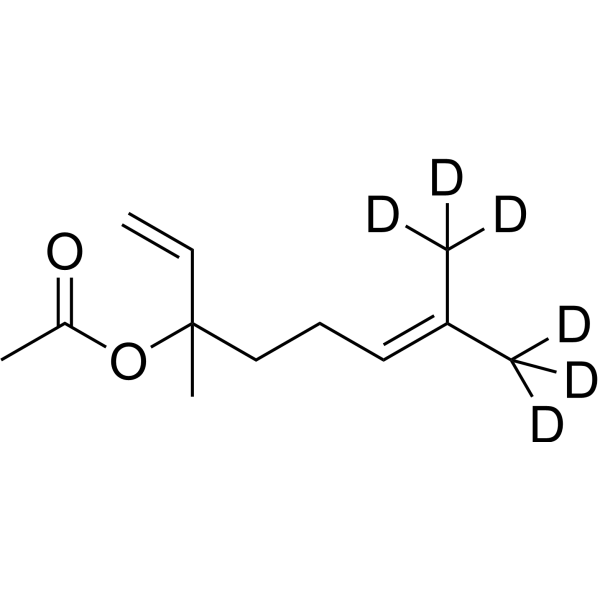
- HY-B0113S4
-
|
H 16868-d3 sodium
|
Autophagy
Phospholipase
Proton Pump
Bacterial
Isotope-Labeled Compounds
|
Infection
Metabolic Disease
Cancer
|
|
Omeprazole-d3 sodium is deuterated labeled Omeprazole (HY-B0113). Omeprazole (H 16868), a proton pump inhibitor (PPI), is available for treatment of acid-related gastrointestinal disorders. Omeprazole shows competitive inhibition of CYP2C19 activity with a Ki of 2 to 6 μM . Omeprazole also inhibits growth of Gram-positive and Gram-negative bacteria .Omeprazole is a potent brain penetrant neutral sphingomyelinase (N-SMase) inhibitor (exosome inhibitor) .
|
-
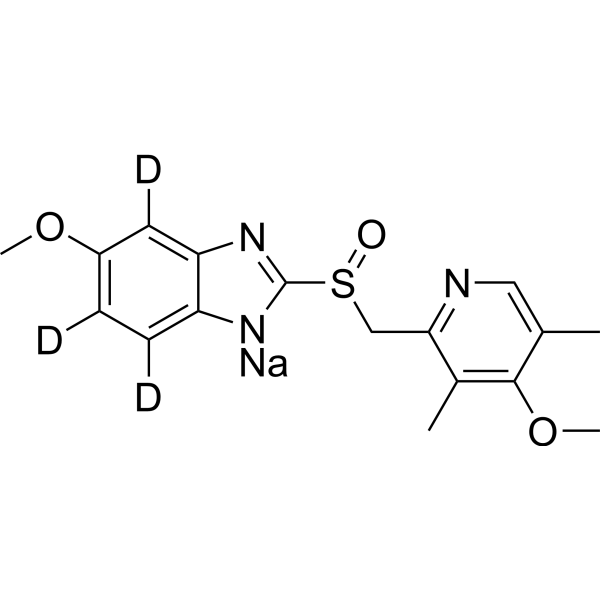
- HY-B0113S3
-
|
H 16868-13C,d3
|
Proton Pump
Autophagy
Bacterial
Phospholipase
|
Infection
Metabolic Disease
Cancer
|
|
Omeprazole- 13C,d3 is a 13C-labeled and deuterium labeled Omeprazole. Omeprazole (H 16868), a proton pump inhibitor (PPI), is available for treatment of acid-related gastrointestinal disorders. Omeprazole shows competitive inhibition of CYP2C19 activity with a Ki of 2 to 6 μM[1]. Omeprazole also inhibits growth of Gram-positive and Gram-negative bacteria[2].Omeprazole is a potent brain penetrant neutral sphingomyelinase (N-SMase) inhibitor (exosome inhibitor)[3].
|
-

- HY-144123
-
|
|
HIV
|
Infection
|
|
HIV-1 inhibitor-16 (compound 7a) is a highly potent HIV-1 inhibitor with an EC50 value of 1.3 nM for HIV-1 WT. HIV-1 inhibitor-16 also has certain inhibitory activity against HIV-1 K103N, E138K, Y181C and L100I strains with EC50s of 5.4 nM, 9.2 nM, 22 nM and 35 nM. HIV-1 inhibitor-16 has favorable solubility and liver microsome stability, and does not exhibit apparent CYP enzymatic inhibitory activity or acute toxicity .
|
-

- HY-13404
-
|
INC280; INCB28060
|
c-Met/HGFR
Apoptosis
|
Cancer
|
|
Capmatinib (INC280; INCB28060) is a potent, orally active, selective, and ATP competitive c-Met kinase inhibitor (IC50=0.13 nM). Capmatinib can inhibit phosphorylation of c-MET as well as c-MET pathway downstream effectors such as ERK1/2, AKT, FAK, GAB1, and STAT3/5. Capmatinib potently inhibits c-MET-dependent tumor cell proliferation and migration and effectively induces apoptosis. Antitumor activity. Capmatinib is largely metabolized by CYP3A4 and aldehyde oxidase .
|
-
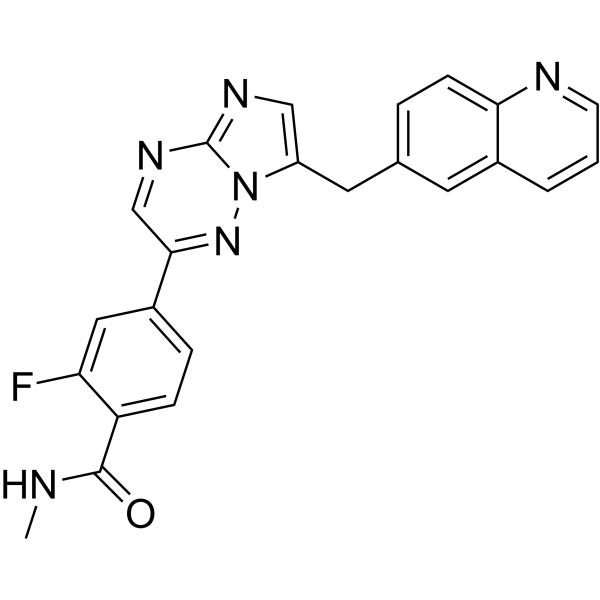
- HY-10965
-
|
KW-3902
|
Adenosine Receptor
|
Neurological Disease
|
|
Rolofylline (KW-3902) is a potent, selective adenosine A1 receptor antagonist that is under development for the treatment of patients with acute congestive heart failure and renal impairment.
Rolofylline is metabolized primarily to the pharmacologically active M1-trans and M1-cis metabolites by cytochrome P450 (CYP450) .
Rolofylline is alleviating the presynaptic dysfunction and restores neuronal activity as well as dendritic spine levels in vitro, is an interesting candidate to combat the hypometabolism and neuronal dysfunction associated with Tau-induced neurodegenerative diseases .
|
-
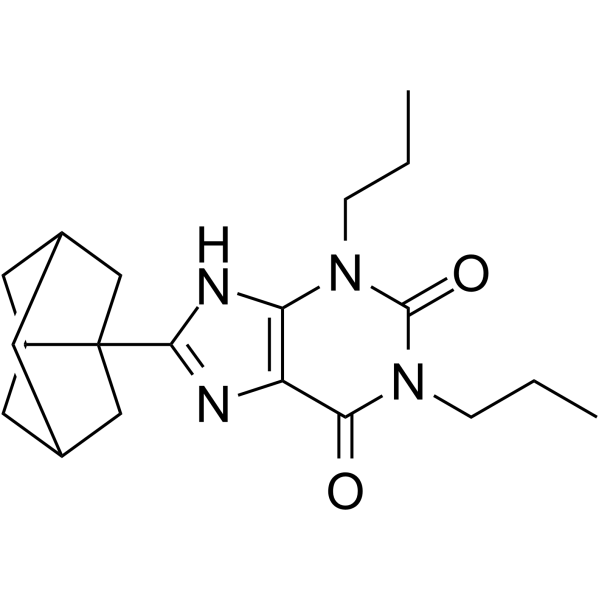
- HY-13404B
-
|
INC280 hydrochloride; INCB-28060 hydrochloride
|
c-Met/HGFR
Apoptosis
|
Cancer
|
|
Capmatinib (INC280; INCB28060) hydrochloride is a potent, orally active, selective, and ATP competitive c-Met kinase inhibitor (IC50=0.13 nM). Capmatinib hydrochloride can inhibit phosphorylation of c-MET as well as c-MET pathway downstream effectors such as ERK1/2, AKT, FAK, GAB1, and STAT3/5. Capmatinib hydrochloride potently inhibits c-MET-dependent tumor cell proliferation and migration and effectively induces apoptosis. Antitumor activity. Capmatinib hydrochloride is largely metabolized by CYP3A4 and aldehyde oxidase .
|
-

- HY-13404C
-
|
INC280 dihydrochloride hydrate; INCB-28060 dihydrochloride hydrate
|
c-Met/HGFR
Apoptosis
|
Cancer
|
|
Capmatinib (INC280; INCB28060) dihydrochloride hydrate is a potent, orally active, selective, and ATP competitive c-Met kinase inhibitor (IC50=0.13 nM). Capmatinib dihydrochloride hydrate can inhibit phosphorylation of c-MET as well as c-MET pathway downstream effectors such as ERK1/2, AKT, FAK, GAB1, and STAT3/5. Capmatinib dihydrochloride hydrate potently inhibits c-MET-dependent tumor cell proliferation and migration and effectively induces apoptosis. Antitumor activity. Capmatinib dihydrochloride hydrate is largely metabolized by CYP3A4 and aldehyde oxidase .
|
-
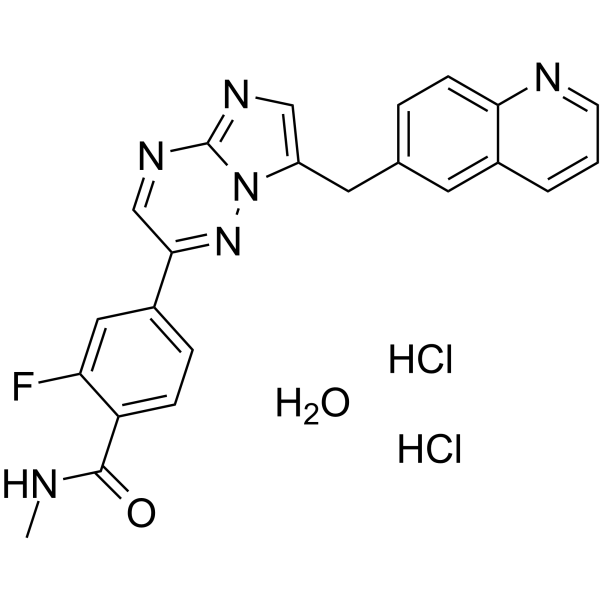
- HY-13404A
-
|
INC280 dihydrochloride; INCB28060 dihydrochloride
|
c-Met/HGFR
Apoptosis
|
Cancer
|
|
Capmatinib (INC280; INCB28060) dihydrochloride is a potent, orally active, selective, and ATP competitive c-Met kinase inhibitor (IC50=0.13 nM). Capmatinib dihydrochloride can inhibit phosphorylation of c-MET as well as c-MET pathway downstream effectors such as ERK1/2, AKT, FAK, GAB1, and STAT3/5. Capmatinib dihydrochloride potently inhibits c-MET-dependent tumor cell proliferation and migration and effectively induces apoptosis. Antitumor activity. Capmatinib dihydrochloride is largely metabolized by CYP3A4 and aldehyde oxidase .
|
-
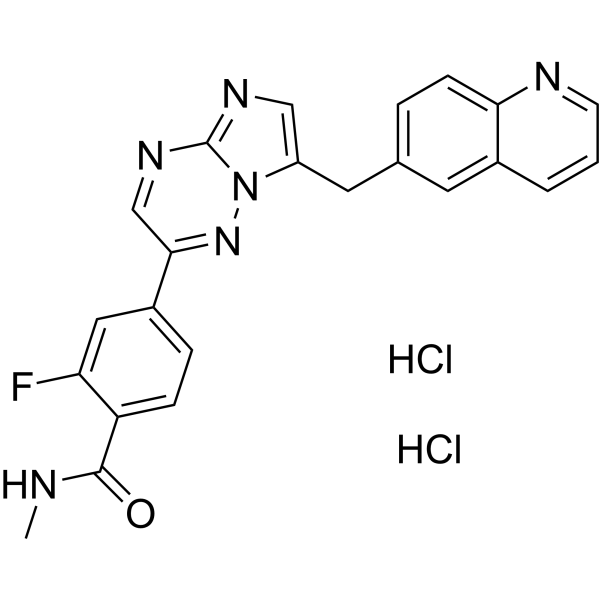
- HY-163436
-
|
|
FXR
Cytochrome P450
RAR/RXR
PPAR
ROR
|
Metabolic Disease
|
|
F44-A13 is an orally active and highly selective farnesoid X receptor (FXR) antagonist with an IC50 value of 1.1 μM. F44-A13 can optimize cholesterol metabolism and reduce its activity by inducing CYP7A1 expression. F44-A13 reduces levels of cholesterol, triglycerides, and low-density lipoprotein cholesterol (LDL-C) in mouse models. F44-A13 can be used in the study of metabolic diseases associated with lipid disorders .
|
-

| Cat. No. |
Product Name |
Type |
-
- HY-D0144
-
|
Methoxyresorufin
|
Chromogenic Substrates
|
|
Resorufin methyl ether (Methoxyresorufin) is a cytochrome P450 fluorometric substrate . Resorufin methyl ether is a relatively specific substrate for CYP1A2 activity in rodents .
|
-
- HY-W271064
-
|
|
Fluorescent Dyes/Probes
|
|
1-Methylpyrene is a ubiquitous environmental pollutant and rodent carcinogen. Its mutagenic activity depends on sequential activation by various CYP and sulfotransferase (SULT) enzymes. 1-Methylpyrene induces chromosome loss and mitotic disturbance, proba
|
-
- HY-116862
-
|
DBF
|
Fluorescent Dyes/Probes
|
|
Dibenzylfluorescein (DBF) is a fluorogenic probe (Fluoresecent dye) that acts as a substrate for specific cytochrome P450 (CYP) isoforms, including CYP3A4, CYP2C8, CYP2C9, CYP2C19, and aromatase (CYP19). Dibenzylfluorescein is typically used near its Km value of 0.87-1.9 µM (Ex=485nm,Em=535nm). Dibenzylfluorescein is used to detect changes in CYP catalytic activity caused by drugs or disease .
|
-
- HY-162051
-
|
|
Fluorescent Dyes/Probes
|
|
CYP1B1-IN-6 (compound 19) is a fluorescence molecular probes which inhibits CYP1B1 activity. CYP1B1-IN-6 can identify tumor sites in fluorescence imaging and photoacoustic imaging modes .
|
-
- HY-D0146
-
|
BzRes; 7-Benzyloxyresorufin; 7-Benzyloxyphenoxazone
|
Dyes
|
|
Resorufin benzyl ether (BzRes), a fluorogenic enzyme substrate, can be used to detect CYP3A4 enzyme activity. Resorufin benzyl ether modified with a recognizing moiety boronate, can be used for ONOO - detection via a self-immolation mechanism. Ex/Em=530-570 nm/590 nm .
|
| Cat. No. |
Product Name |
Target |
Research Area |
-
- HY-144285
-
|
|
CXCR
HIV
|
Inflammation/Immunology
|
|
CXCR4 antagonist 4 is a potent, orally active CXCR4 antagonist (IC50=24 nM) with diminished CYP 2D6 activity, improved PAMPA permeability, potent inhibition of human immunodeficiency virus entry (IC50=7 nM) .
|
| Cat. No. |
Product Name |
Category |
Target |
Chemical Structure |
-
- HY-N0453
-
-

-
- HY-N0482
-
-

-
- HY-N0598
-
-

-
- HY-N2071
-
Cedrol
1 Publications Verification
(+)-Cedrol; α-Cedrol
|
Cedrus deodara (Roxburgh) G. Don
Classification of Application Fields
Pinaceae
Terpenoids
Sesquiterpenes
Source classification
Plants
Inflammation/Immunology
Disease Research Fields
Cancer
|
Cytochrome P450
Fungal
|
|
Cedrol is a bioactive sesquiterpene, a potent competitive inhibitor of cytochrome P-450 (CYP) enzymes. Cedrol inhibits CYP2B6-mediated bupropion hydroxylase and CYP3A4-mediated midazolam hydroxylation with Ki of 0.9 μM and 3.4 μM, respectively. Cedrol also has weak inhibitory effect on CYP2C8, CYP2C9, and CYP2C19 enzymes . Cedrol is found in cedar essential oil and poetesses anti-septic, anti-inflammatory, anti-spasmodic, tonic, astringent, diuretic, insecticidal, and anti-fungal activities .
|
-

-
- HY-N0693
-
-

-
- HY-119804
-
-

-
- HY-W010195
-
-

-
- HY-N0921
-
-

-
- HY-N0125
-
-

-
- HY-N0043
-
-

-
- HY-N0382
-
-

-
- HY-N0043R
-
-

-
- HY-N2425
-
-

-
- HY-N0904
-
-

-
- HY-W008364
-
-

-
- HY-N0144
-
-

-
- HY-N0494
-
-

-
- HY-N9434
-
-

-
- HY-N7454
-
-

-
- HY-N11706
-
-

-
- HY-113327
-
-

-
- HY-W087008
-
-

-
- HY-N0125R
-
-

-
- HY-N0382R
-
-

-
- HY-N0904R
-
-

-
- HY-N10344
-
-

-
- HY-N9203
-
-

-
- HY-N0692
-
-

-
- HY-W008226
-
-

-
- HY-N6972
-
-

-
- HY-N2689
-
-

-
- HY-N3841
-
-

-
- HY-117010
-
-

-
- HY-N3841A
-
-

-
- HY-N0453R
-
-

| Cat. No. |
Product Name |
Chemical Structure |
-
- HY-70013S
-
|
|
|
Abiraterone-d4 is the deuterium labeled Abiraterone. Abiraterone is a potent and irreversible CYP17A1 inhibitor with antiandrogen activity, which inhibits both the 17α-hydroxylase and 17,20-lyase activity of the cytochrome p450 enzyme CYP17 with IC50s of 2.5 nM and 15 nM, respectively.
|
-

-
- HY-W754151
-
|
|
|
N-Desmethyl apalutamide-d4 is the deuterium-labeled N-Desmethyl-Apalutamide (HY-135331). N-Desmethyl Apalutamide is an active metabolite of Apalutamide. N-Desmethyl Apalutamide is a less potent antagonist of the androgen receptor and is responsible for one-third of the activity of Apalutamide. The formation of N-Desmethyl Apalutamide mediated predominantly by CYP2C8 and CYP3A4. N-Desmethyl Apalutamide is moderate to strong CYP3A4 and CYP2B6 inducer and has an excellent plasma-proteins bound concentration .
|
-

-
- HY-N0893S
-
|
|
|
Tetrahydrocurcumin-d6 is a deuterium labeled Tetrahydrocurcumin. Tetrahydrocurcumin is a Curcuminoid which displays inhibitory activity for CYP2C9 and CYP3A4[1].
|
-

-
- HY-B0822S1
-
|
|
|
Fipronil- 13C6 is the 13C-labeled Fipronil. Fipronil is an insecticide that acts as a selective antagonist of insect GABA receptors (IC50s = 30 nM and 1,600 nM for cockroach and rat receptors, respectively). Fipronil also inhibits desensitizing and non-desensitizing glutamate-induced chloride currents in cockroach neurons (IC50s = 800 nM and 10 nM, respectively). Fipronil induces activity of the cytochrome P450 (CYP) isoforms CYP1A1/2, CYP2B1/2, and CYP3A1/2 in isolated rat liver microsomes.
|
-

-
- HY-100665S
-
|
|
|
Dehydroaripiprazole-d8 is deuterium labeled Dehydroaripiprazole. Dehydroaripiprazole (OPC-14857) is an active metabolite of Aripiprazole. Aripiprazole is an antipsychotic agent and is metabolized by CYP3A4 and CYP2D6 forming mainly Dehydroaripiprazole. Dehydroaripiprazole has with antipsychotic activity equivalent to Aripiprazole[1][2][3].
|
-

-
- HY-13463BS
-
|
|
|
Avatrombopag-d8 (hydrochloride) is deuterium labeled Avatrombopag (hydrochloride). Avatrombopag (AKR-501) hydrochloride is an orally active, nonpeptide thrombopoietin (TPO) receptor agonist (EC50=3.3 nM). Avatrombopag hydrochloride mimics the biological activities of TPO. Avatrombopag hydrochloride increases platelet production by activating the intracellular signaling system, and promotes production of platelets and megakaryocytes from hemopoietic precursor cells. Avatrombopag hydrochloride is a substrate of cytochrome P450 (CYP) 2C9 and CYP3A[1][2][3].
|
-

-
- HY-10882S
-
|
|
|
Clotrimazole-d5 is the deuterium labeled Clotrimazole. Clotrimazole is an imidazole derivative, an antifungal compound and is a CYP (cytochrome P450) inhibitor. Clotrimazole has antibacterial activity[1][2].
|
-

-
- HY-14874S
-
|
|
|
Topiroxostat-d4 is deuterium labeled Topiroxostat. Topiroxostat (FYX-051) is a potent and orally active xanthine oxidoreductase (XOR) inhibitor with an IC50 value of 5.3 nM and a Ki value of 5.7 nM. Topiroxostat exhibits weak CYP3A4-inhibitory activity (18.6%). Topiroxostat has the potential for hyperuricemia treatment[1][2].
|
-

-
- HY-N0125S
-
|
|
|
Diosmetin-d3 is the deuterium labeled Diosmetin. Diosmetin is a natural flavonoid which inhibits human CYP1A enzyme activity with an IC50 of 40 μM in HepG2 cell.
|
-

-
- HY-10882S1
-
|
|
|
Clotrimazole-d10 is deuterated labeled Clotrimazole (HY-10882). Clotrimazole is an imidazole derivative, an antifungal compound and is a CYP (cytochrome P450) inhibitor. Clotrimazole has antibacterial activity.
|
-

-
- HY-N0382S
-
|
|
|
Galangin- 13C3 is the 13C-labeled Galangin. Galangin (Norizalpinin) is an agonist/antagonist of the arylhydrocarbon receptor. Galangin (Norizalpinin) also shows inhibition of CYP1A1 activity.
|
-

-
- HY-17508S1
-
|
|
|
Clarithromycin-d3is the deuterium labeledClarithromycin(HY-17508) . Clarithromycin has a broad spectrum of antimicrobial activity. Clarithromycin inhibits the CYP3A4-catalyzed triazolam alpha-hydroxylation with the IC50 (Ki) value of 56 (43) μM . Clarithromycin significantly inhibits the HERG potassium current .Clarithromycin affects the autophagic flux by impairing the signaling pathway linking hERG1 and PI3K .
|
-

-
- HY-75054S
-
|
|
|
Abiraterone acetate-d4 is the deuterium labeled Abiraterone acetate. Abiraterone acetate (CB7630) is an oral, potent, selective, and irreversible inhibitor of CYP17A1 with antiandrogen activity. Abiraterone acetate is a proagent form of Abiraterone (CB7598).
|
-

-
- HY-122277S
-
|
|
|
1'-Hydroxy bufuralol-d9 is a deuterium labeled 1'-Hydroxy bufuralol (HY-122277). 1'-Hydroxy bufuralol, the main metabolite of bufuralol, can reflect CYP2D activity .
|
-

-
- HY-100064S
-
|
|
|
O-Desmethyl gefitinib-d8 is a deuterium labeled O-Desmethyl gefitinib. O-Desmethyl gefitinib is an active metabolite of Gefitinib in human plasma. The formation of O-desmethyl gefitinib is dependent on CYP2D6 activity. O-desmethyl gefitinib inhibits EGFR with an IC50 of 36 nM in subcellular assays[1][2].
|
-

-
- HY-100064S1
-
|
|
|
O-Desmethyl gefitinib-d6 is the deuterium labeled O-Desmethyl gefitinib. O-Desmethyl gefitinib is an active metabolite of Gefitinib in human plasma. The formation of O-desmethyl gefitinib is dependent on CYP2D6 activity. O-desmethyl gefitinib inhibits EGFR with an IC50 of 36 nM in subcellular assays[1][2].
|
-

-
- HY-B0113S
-
|
|
|
Omeprazole-d3 is deuterium labeled Omeprazole. Omeprazole, a proton pump inhibitor (PPI), is available for treatment of acid-related gastrointestinal disorders. Omeprazole shows competitive inhibition of CYP2C19 activity with a Ki of 2 to 6 μM[1]. Omeprazole also inhibits growth of Gram-positive and Gram-negative bacteria[2].
|
-

-
- HY-B1462S
-
|
|
|
Chlorzoxazone-d3 is the deuterium labeled Chlorzoxazone. Chlorzoxazone is a centrally acting muscle relaxant used to treat muscle spasm and the resulting pain or discomfort. It acts on the spinal cord by depressing reflexes.Chlorzoxazone is currently being used as a marker substrate in vitro/vivo studies to quantify cytochrome P450 2E1 (CYP2E1) activity in humans.
|
-

-
- HY-B0113S1
-
|
|
|
Omeprazole-d3-1 is the deuterium labeled Omeprazole. Omeprazole (H 16868), a proton pump inhibitor (PPI), is available for treatment of acid-related gastrointestinal disorders. Omeprazole shows competitive inhibition of CYP2C19 activity with a Ki of 2 to 6 μM[1]. Omeprazole also inhibits growth of Gram-positive and Gram-negative bacteria[2].Omeprazole is a potent brain penetrant neutral sphingomyelinase (N-SMase) inhibitor (exosome inhibitor)[3].
|
-

-
- HY-N6948S
-
|
|
|
Linalyl acetate-d6 is deuterated labeled Omeprazole (HY-B0113). Omeprazole (H 16868), a proton pump inhibitor (PPI), is available for treatment of acid-related gastrointestinal disorders. Omeprazole shows competitive inhibition of CYP2C19 activity with a Ki of 2 to 6 μM . Omeprazole also inhibits growth of Gram-positive and Gram-negative bacteria .Omeprazole is a potent brain penetrant neutral sphingomyelinase (N-SMase) inhibitor (exosome inhibitor) .
|
-

-
- HY-B0113S4
-
|
|
|
Omeprazole-d3 sodium is deuterated labeled Omeprazole (HY-B0113). Omeprazole (H 16868), a proton pump inhibitor (PPI), is available for treatment of acid-related gastrointestinal disorders. Omeprazole shows competitive inhibition of CYP2C19 activity with a Ki of 2 to 6 μM . Omeprazole also inhibits growth of Gram-positive and Gram-negative bacteria .Omeprazole is a potent brain penetrant neutral sphingomyelinase (N-SMase) inhibitor (exosome inhibitor) .
|
-

-
- HY-B0113S3
-
|
|
|
Omeprazole- 13C,d3 is a 13C-labeled and deuterium labeled Omeprazole. Omeprazole (H 16868), a proton pump inhibitor (PPI), is available for treatment of acid-related gastrointestinal disorders. Omeprazole shows competitive inhibition of CYP2C19 activity with a Ki of 2 to 6 μM[1]. Omeprazole also inhibits growth of Gram-positive and Gram-negative bacteria[2].Omeprazole is a potent brain penetrant neutral sphingomyelinase (N-SMase) inhibitor (exosome inhibitor)[3].
|
-

| Cat. No. |
Product Name |
|
Classification |
-
- HY-119647
-
|
|
|
Alkynes
|
|
PPOH, a fatty acid derivative, is a selective cyclooxygenase (COX) inhibitor that inhibits arachidonic acid cyclooxygenase activity in renal cortical microsomes. In addition, PPOH acts on CYP4A2 and CYP4A3 with the IC50 values of 22 μM and 6.5 μM, respectively . PPOH is a click chemistry reagent, it contains an Alkyne group and can undergo copper-catalyzed azide-alkyne cycloaddition (CuAAc) with molecules containing Azide groups.
|
Your information is safe with us. * Required Fields.
Inquiry Information
- Product Name:
- Cat. No.:
- Quantity:
- MCE Japan Authorized Agent:







































































































































































